

A New Era
Meet Binghamton University President Anne D’Alleva
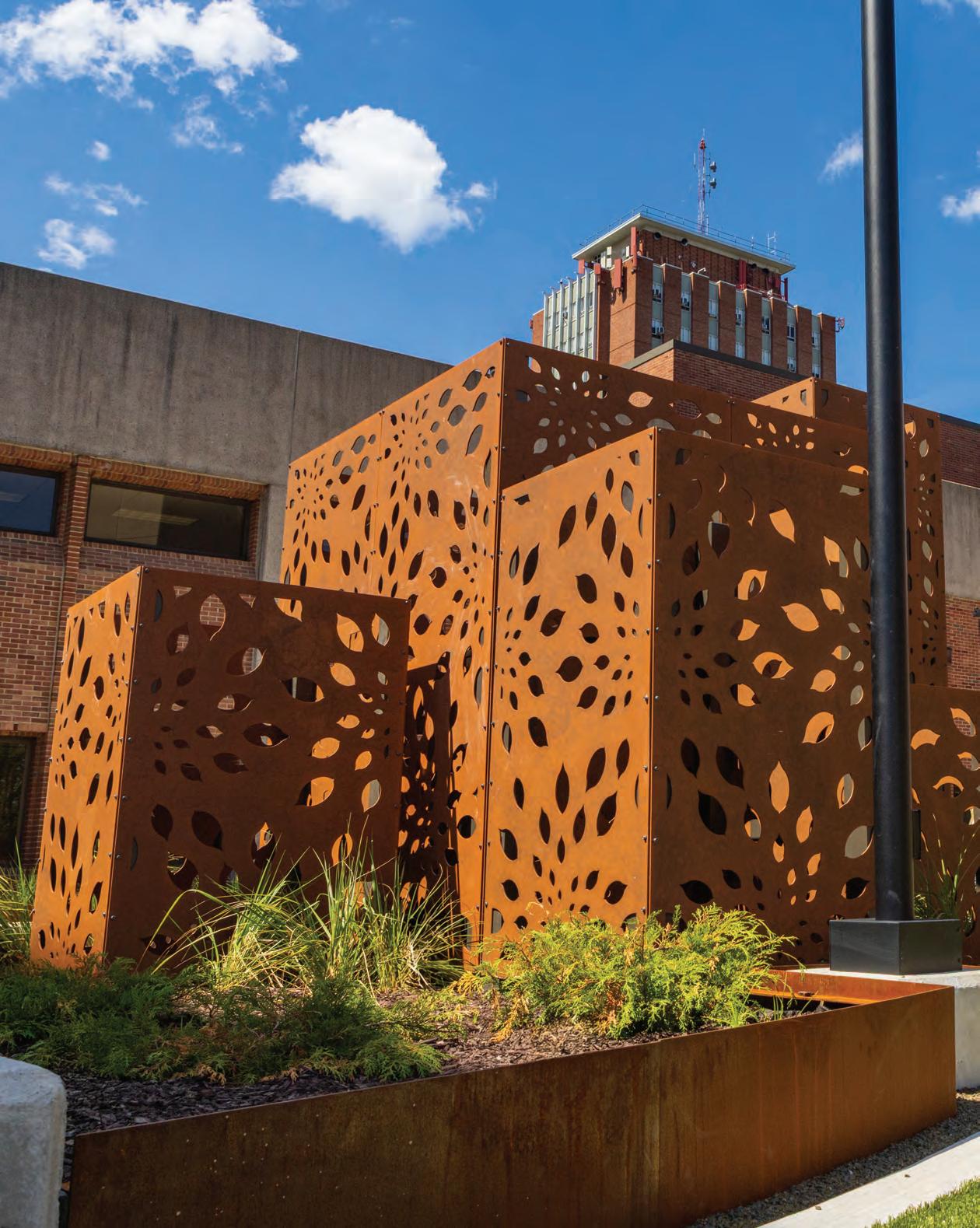
New art panels and turf have been installed on the Plaza Deck, the area that connects the University Union, the Glenn G. Bartle Library, the Technology Hub and the Engineering Building.
FEATURES
4
Life in harmony
Singer Tshombe Selby, MM ’22, shines on stage and behind the scenes at the Metropolitan Opera in New York City.
10
A summer on Ontong Java
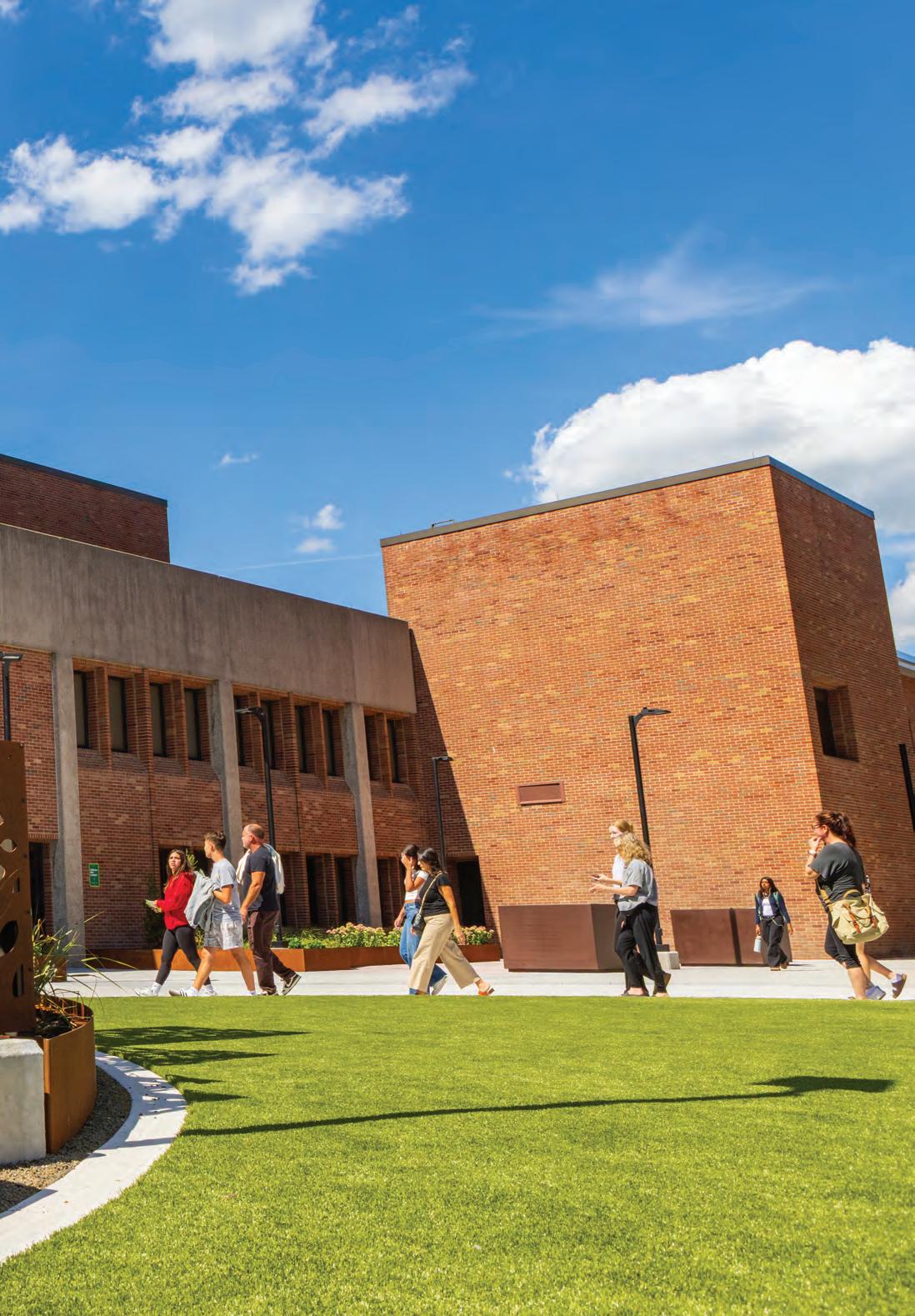
Anthropologist and professor Carl Lipo conducts the first research in more than a century on the remote Pacific Ocean island.
14
Transforming television
TV giant Gary Levine ’74, MBA ’76, reflects on a career developing hit shows such as Dexter, Yellowjackets, Homeland and Weeds.
20
Putting nature first
The Southern Tier Land Conservancy — a group of alumni and faculty members — works to preserve the region’s natural landscape.
24
Meet Anne D’Alleva
Binghamton’s eighth president arrives from the University of Connecticut, where she was provost and executive vice president for academic affairs.
MORE
28 / A salute to veterans
36 / Connect: On the move at JFK Airport; Q&A with a United Nations legal officer; Class Notes; new book releases; Book Talk

I am truly honored — and excited — to become Binghamton University’s president. As a native New Yorker, I’ve long admired the University from afar and I am looking forward to working toward continuing its strong traditions of research, scholarship and educating students for lifetime success.
Binghamton’s 160,000 alumni are central to my plans for the University’s future. You know its quality firsthand. Having been shaped, inspired and enlightened by your experiences as a student, you are making a positive difference in the world.
No matter where life has taken you after graduation, I believe that you, as alumni, can be part of strengthening and expanding Binghamton’s role as a leader in public higher education. There are several ways in which you can stay involved or begin to connect with the University, including volunteering your time at an event, sharing your professional expertise and experiences with students, serving as a mentor or internship host, or contributing financially to a cause that is meaningful to you.
Binghamton’s reputation has been built over decades because of your excellence as students and your accomplishments since. I am deeply grateful for how you’ve contributed to this wonderful community and I hope that you consider how you might continue to engage with it in the years ahead.
Sincerely,
ANNE D’ALLEVA PRESIDENT

EDITORIAL
UNIVERSITY MAGAZINE EDITOR
Eric Coker
ALUMNI EDITOR
Steve Seepersaud
DESIGN AND PRODUCTION
Angelo Garufi, Burt Myers, David Skyrca ’85
UNIVERSITY PHOTOGRAPHER
Jonathan Cohen
COPY EDITORS
John Brhel, Ethan Knox ’20, Chris Kocher, Steve Seepersaud, Emma Young ’26
VICE PRESIDENT FOR UNIVERSITY COMMUNICATIONS AND MARKETING
Greg Delviscio
SENIOR DIRECTOR OF CREATIVE SERVICES
Gerald Hovancik Jr.
EXECUTIVE DIRECTOR OF ALUMNI ENGAGEMENT
Matthew Winston Jr.
HOW TO CONTACT US
LETTERS, NEWS AND STORY IDEAS
Telephone: 607-777-6441
Email: magazine@binghamton.edu
CHANGE OF ADDRESS Office of Alumni Engagement PO Box 6000
Binghamton, NY 13902-6000
Email: alumni@binghamton.edu
CLASS NOTES
Submit them by visiting bconnectalumni.binghamton.edu

University breaks ground on new academic building
The new Classroom and Lecture Hall Building project kicked off July 30 with a groundbreaking ceremony.
Located across from Academic A and adjacent to Lot M, the new building will include three lecture halls, one activelearning classroom, three computer classrooms, 33 general purpose classrooms, several testing rooms, and a Bearcat Commons with group study rooms designed to facilitate collaboration and focused learning.
The new building, planned for completion in 2027, will not replace the original and current Lecture Hall building.
An addition to the University’s oldest building — the East Gym — is expected to be complete in fall 2026. The 75,000-square-foot addition will include three new gym courts, an expanded FitSpace and an elevated running track.
CCPA founding dean Ingraham dies
Patricia Ingraham, PhD ’79, founding dean of the College of Community and Public Affairs (CCPA), died June 22 at age 82.
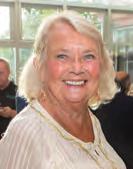
Ingraham was named dean in August 2006 to lead CCPA, which was spun off from the reorganization of the School of Education and Human Development. She led the college for seven years, overseeing the move into the University Downtown Center and strengthening ties in the community, before retiring in 2013.
“It was very brave of the faculty and staff to leave Vestal and go downtown,” she recalled in 2016. “Nobody likes to feel
separated from the rest of the campus. From setting up our library to making sure there was a place for students to buy coffee to determining an efficient bus schedule, there was a collaborative, high-quality effort to open the University Downtown Center.”
Besides teaching at Binghamton and Syracuse University, Ingraham wrote numerous articles in peer-reviewed journals, including an article that was selected as one of the 50 most influential articles in the history of Public Administration Review, the leading academic journal in her field.
Fall magazine earns design award
The fall 2024 issue of Binghamton University Magazine received top design honors at the State University of New York Council for University Advancement (SUNYCUAD) 2025 Awards for Excellence.
The magazine, which featured alumna Olympian Emily Mackay on the cover, was named “Best of Category (seven-plus staff).” The issue was designed by Burt Myers, Katie Samson ’14 and David Skyrca ’85 from the University’s Division of Communications and Marketing.
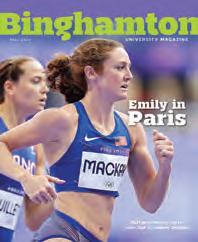
The trio redesigned Binghamton University Magazine in 2023.
25 years of Division I sports

This fall marks the 25th year since Binghamton University arrived at the NCAA’s highest level of athletics. The new issue of Winning Edge looks back at how Binghamton made the leap to Division I and catches up with some of the student-athletes who have excelled since 2001.
issuu.com/binghamtonu/docs/ binghamton_winning_edge_fall_2025



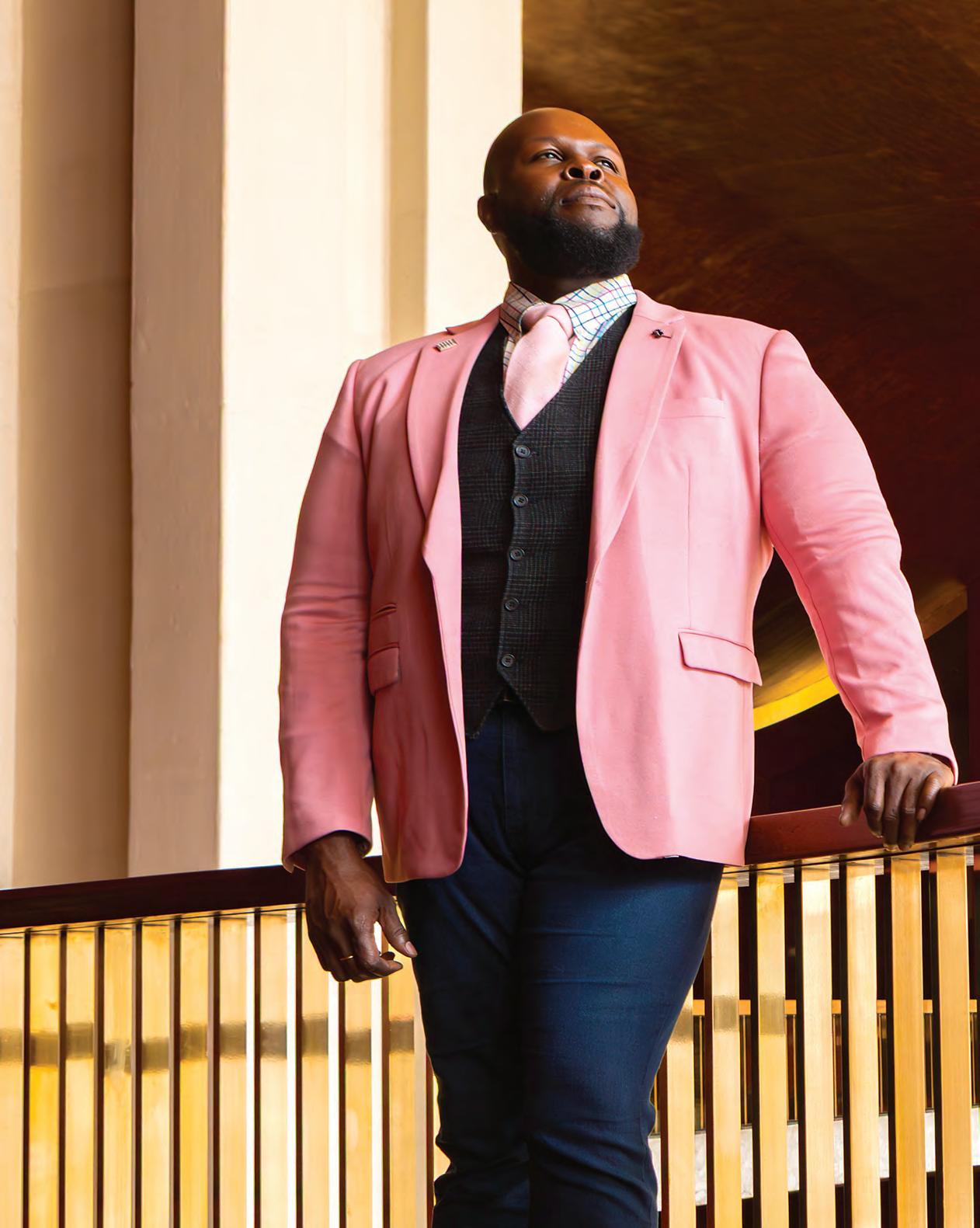


Opera singer and Binghamton University alumnus Tshombe Selby has performed in Metropolitan Opera productions such as Götterdämmerung and Fire Shut Up in My Bones.
HITTING ALL THE RIGHT NOTES AT THE MET
B
By Rachel Coker
You can find alumnus Tshombe Selby performing on stage and assisting backstage at Lincoln Center
When tenor Tshombe Selby, MM ’22, walks through the doors of the Metropolitan Opera House, no role is too large or too small for him. Whether he’s taking a solo bow on stage or guiding patrons to their seats as an usher, Selby takes pride in the job.
On a summer morning, workers have lowered the massive chandelier that usually shines over the grand staircase and its crimson carpet. Selby, 41, pauses and looks down to see how it’s going.
“People take more pictures with the chandeliers than they take with the stars of the opera,” he notes. “That’s their opportunity to be a part of the Met. So, when I was able to touch every one of those crystals and clean them, I was proud.
“When I was an usher, you didn’t mess up in my area. There’s no talking. You will not have your cell phone out. You’re going to have respect for these people, respect for this house, respect for my section, respect for this art form. The same respect I have wearing my usher uniform is the same respect I have when I put on my costume: This is my opportunity. I’m going to do my job.”






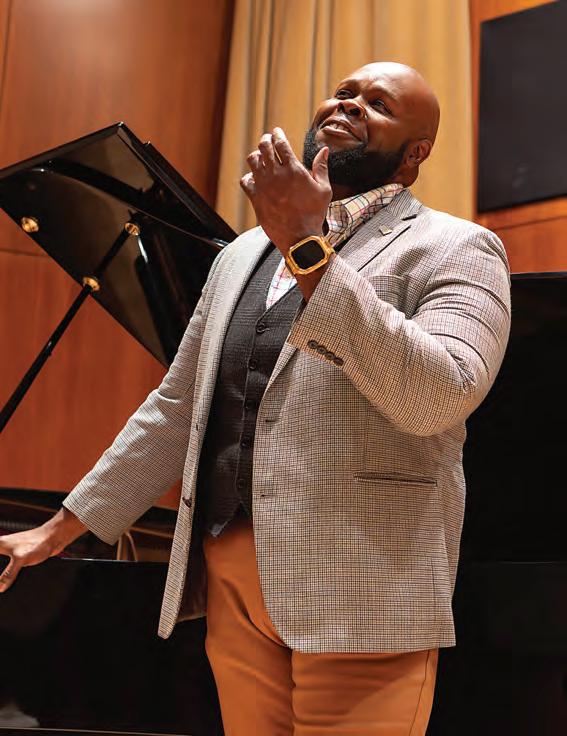

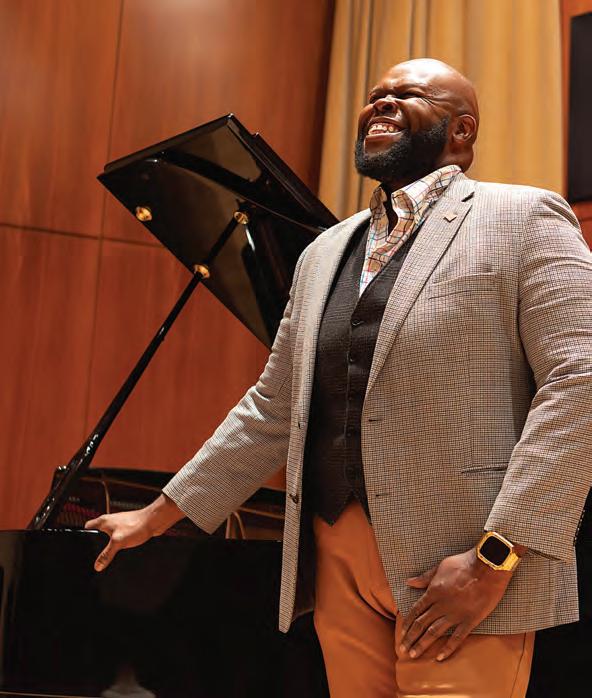
“I didn’t want to do something that everybody could do. So, I wanted to become an opera singer.”
— Tshombe Selby
Growing up in Manteo, N.C., Selby sang in church and in school. He enrolled as an undergraduate at Elizabeth City State University (ECSU) with plans to become a high school principal and sing in the choir. School administrators start off in the classroom, so he thought he’d begin his career as a music teacher. At the time, he couldn’t read music.
At ECSU, Selby strengthened his fundamentals and soon mastered an aria for the first time: La donna è mobile, a famous showcase for tenors like Luciano Pavarotti, from Giuseppe Verdi’s opera Rigoletto. It’s well known to American audiences from commercials for products ranging from pasta sauce to Axe body spray.



“I was listening to YouTube, and I heard Pavarotti singing the cadenza,” Selby remembers. “I went back to my teacher, and I was like, ‘I want to try this one.’”
From that time on, Selby chased a dream


of becoming an opera singer. He continued to travel back and forth to school after his father suffered a stroke, and when he took time away from classes after his father died, choir director Billy Hines allowed him to continue singing with the group.
He always hoped to make his way to the stage.
“I found my love for grandeur in church,” Selby says. “The choir would march in, that’s very grand. We’re Southern Baptists, so it was a lot of ceremonial things, something you don’t do every day. … And opera is not something you do every day. It’s make-believe, but it’s real lives. It drew me. I didn’t want to do something that everybody could do. So, I wanted to become an opera singer.”
That drive powered Selby through a period when he traveled two hours each way for voice lessons, and eventually took him to an outdoor
“He really had a profound impact on our vocal program in the two years he was here.”

Thomas Goodheart, Binghamton University associate professor of voice, about Tshombe Selby

theatrical production called The Lost Colony, which tells the story of the first attempt at English colonization in America.
Through his work in the cast of The Lost Colony, Selby met opera coaches Carol and Nico Castel, as well as theater director Charles Massey and his brother Bill Massey, an arts administrator. A team of friends and mentors encouraged Selby to go to New York to advance his career and Charles Massey helped him land a position as an usher at the Met in 2013 through a friend.
By 2015, Selby had his debut at Carnegie Hall. He kept improving his craft, performing with the Delaware Valley Opera in the Catskills and Opera NUOVA in Canada.
While working as an usher at the Met, he met Elinor Ross. She was in her late 80s by then, but Ross had once been a powerhouse soprano.
“I befriended her, and she was so kind to me and gave me guidance,” Selby says.
B
Besides singing for the Metropolitan Opera, Tshombe Selby has worked behind the scenes as an usher, a spotlight operator and in the titles booth at the Metropolitan Opera House at Lincoln Center in New York City.
Ross introduced him to Joseph Lawson, then the assistant chorus master at the Met. Lawson turned out to be a longtime friend of Carol Castel and agreed to coach Selby. Soon Selby had an audition and landed a spot in the chorus of Porgy and Bess.
One day, as he was driving down the New Jersey Turnpike, he received a call from the Met asking if he would like to be in Götterdämmerung, part of Richard Wagner’s Ring cycle.

“I said, ‘Oh yeah, I do.’ They said, ‘Well, be at rehearsal tomorrow.’ So, there I went one day from being an usher to being on stage, being in rehearsal at the Met and being a singer,” Selby says.
In one sense, he wasn’t that nervous: He had already spent so many hours in the building.
But walking on stage for rehearsal evoked a new feeling.

“My legs were like jelly because I was walking where Pavarotti and Leontyne Price walked,” Selby remembers.
Selby’s career was starting to take shape at this point, but he was still searching for intellectual validation. That’s what brought him to the Master of Music in Opera program at Binghamton, where he received a Clifford D. Clark Fellowship.

ROLES OF A LIFETIME
TSelby describes Christopher Bartlette, an associate professor of music, as a “theory god” who helped him strengthen his understanding of the technical and historical elements of opera.
“He worked with me and really catered to every student’s strong points,” Selby says. “And then, in their weak points, he would cultivate that so it wouldn’t be so weak anymore.”
Thomas Goodheart, associate professor of voice at Binghamton, remembers Selby as an exceptionally upbeat student, a hard worker as well as a leader.
“He really had a profound impact on our vocal program in the two years he was here,” Goodheart says. “He was a very positive, very supportive person. That’s also how he was in our lessons and in performing.”
shombe Selby has appeared in a variety of roles with the Metropolitan Opera, with parts in classics such as Giacomo Puccini’s Turandot, as well as modern works such as Anthony Davis’ X: The Life and Times of Malcolm X.
Performing in Champion and Fire Shut Up in My Bones, English-language operas by the American composer Terence Blanchard, offered Selby an experience he might not
have playing a part like Rodolfo in La Bohème.
“I had the chance to portray Black people, which is something interesting,” he says, recalling a moment in the juke joint scene in Fire Shut Up in My Bones. “That was a real moment where I kind of was like, ‘Y’all, I’m being us.’ Because oftentimes you’re Rodolfo, you’re Italian, you’re somebody else. But to be you was a surreal moment.”
Selby also aspires to the iconic

Selby’s time on campus coincided with the pandemic, so he did not have a traditional student experience. Still, he performed with Tri-Cities Opera in The Elixir of Love and did coursework in diction, foreign languages and history in addition to vocal lessons.
Goodheart has worked with other Binghamton students who went on to success at opera’s highest levels, notably soprano Caitlin Gotimer ’15 and mezzo-soprano Lindsay Kate Brown, MM ’16. He says it’s not enough for a performer to have a great voice; drive and dedication as well as other qualities can help singers stand out. Selby, he notes, brings a pathos and understanding to his roles and somehow retains a kind of vulnerability on stage.
“Yes, he has a lovely voice, but he expresses everything he has experienced in his life through his singing,” Goodheart says. “That’s not something you learn. That’s something you have in your personality. Listening to him sing is different. You’re drawn to that.”
Before Selby had finished his last class at Binghamton, he returned to the city, where he performed at the Met in two Terence Blanchard operas: Fire Shut Up in My Bones and Champion.
Selby also continued working as an usher, which is where he met Philip Volpe, a master electrician who offered him a job running the opera titles. (Opera titles are like subtitles for a foreign film: They’re projected above the stage
and allow the audience to read in English and follow the storyline while performers are singing in another language.)
“That’s how I became a stagehand. I ended up in the titles booth,” Selby says. “And then last season, I needed some more work. So, I also became a spotlight operator.”
Through it all, Selby remains positive. One season, he was in 11 shows; the next he had parts in just three.
“I was running the spotlight, and I had a moment to think,” he remembers. “I said, ‘You know, I’m working the spotlight now that was shining on me.’ And in that moment, you could feel like, ‘Oh, I’ve really downgraded.’ But I’m working.”
Whatever the task, Selby says, he asks questions and stays humble. Just as he spends time reviewing a score for a performance, he has taken rope home to practice tying knots to improve his work as a stagehand.
“People in the Met sometimes call me the mayor, because I’m always around just doing everything,” Selby says. “There is not a job that I won’t try, because work is work. And there’s nothing wrong with making an honest day’s wage.”
tenor roles: Alfredo in Giuseppe Verdi’s La Traviata, for example, or Tamino in Mozart’s The Magic Flute
“It feels fun to have the football, to run with the football,” says Selby, reaching for a sports metaphor. “It feels good to get to run the football across, you know, to sing a high C on the stage. Now, I have sung C’s on the stage. They were with the other men in the chorus. But to carry that football across the end zone must feel real good.”


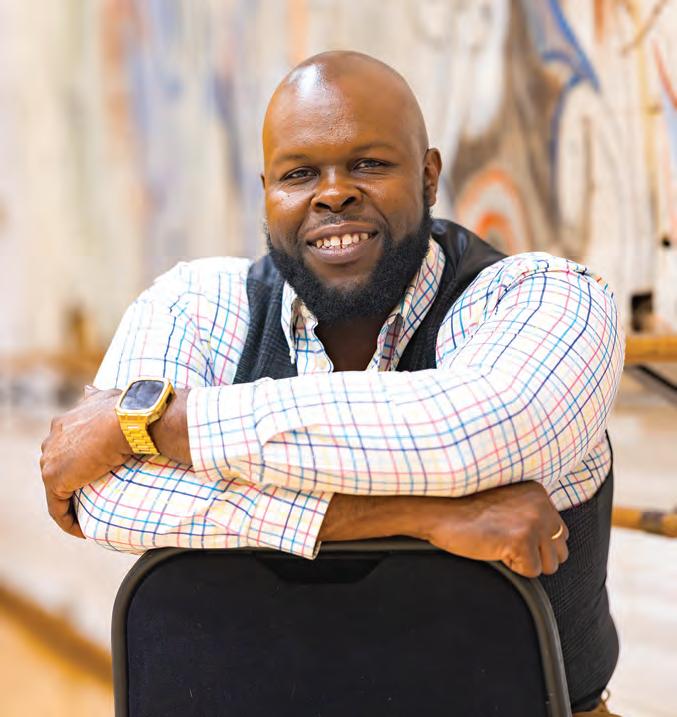

HIDDEN HOMELAND
Archaeologist
Carl Lipo
gets a once-in-a-lifetime opportunity: Performing the first excavation on a Pacific island
By Jennifer Micale
E
aster Island — or Rapa Nui in the native language — is known around the world for its massive moai statues. While the physical origins of the statues can be traced to a quarry on the remote island, where did the idea behind them come from?
To find out, Binghamton University Anthropology Professor Carl Lipo, University of Arizona archaeologist Terry Hunt, and Christopher Filimoehala and Timothy Rieth from the International Archeological Research Institute traveled in late July to Ontong Java, the largest atoll in the world. Their findings could upend a 100-year-old story about the Pacific islands and how they were settled.
This could be the homeland for all of eastern Polynesia, but the only way to know is to go there.”
— CARL LIPO
“Perhaps the craziest thing about this is that no archaeology has ever been done on these islands,” Lipo explains. “For the most part, they haven’t been studied since German researchers were poking around in 1899 and later in the 1920s. That work is the extent of our knowledge about these people’s material culture and history. But the hints we have suggest that these places may be the root of all of eastern Polynesia: the great-grandparents of Rapa Nui.”
Ancestor worship is found throughout the Polynesian islands, which means that the practice must have
originated in a homeland from which they dispersed. Something happened in the 13th century of the common era that led the Polynesian people to sail for distant shores, landing on places as diverse as Hawaii, New Zealand, Rapa Nui and Tahiti around the same time, bringing their language, traditions, cultural artifacts and technologies.
“The question is: Where does all that come from? The traditional answer has been Samoa,” Lipo says. A large island in the central Pacific, Samoa has been occupied for nearly 4,000 years. But there’s a problem with that theory: Many of the cultural features and artifacts of eastern Polynesia, including carved, upright stones and specific forms of ancestor worship, aren’t found in Samoa.
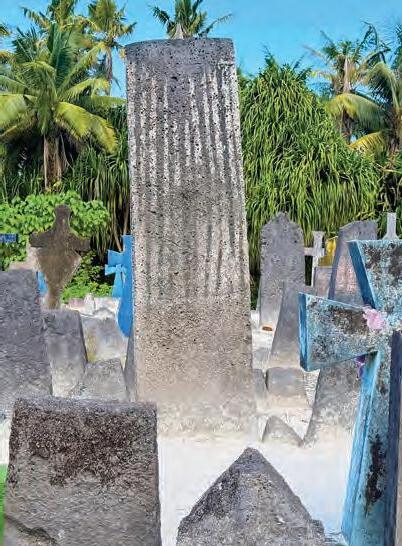

eastern Polynesia. Tiny and remote, these islands have been largely inaccessible to any except the most determined researchers.
“This could be the homeland for all of eastern Polynesia, but the only way to know is to go there,” Lipo recounts.
And the time for that journey must be now: Rising sea levels threaten the future of islands such as Ontong Java. Climate change raises sea levels and worsens storms, potentially sweeping parts of the island into the sea. There are other factors, too; saltwater intrusion into the groundwater makes it increasingly difficult for islanders to grow food crops.
University of Hawaii linguist
William “Pila” Wilson has a theory: The homeland of the eastern Polynesian peoples lay in the “northern outlier” islands far west of Samoa, located between Micronesia and the Solomon Islands. There are linguistic links between the languages spoken there and those of
“The island isn’t that wide; a typhoon could easily blow across and a storm surge could wipe it out,” Lipo explains. “Will it be in 20 years, 30 years? They’re at the front lines of climate change. There’s a definite urgency.”
The journey
Stretching 150 miles, Ontong Java consists of a thin strip of land bending around a central lagoon. Reaching it is no easy task; there are no airports or ferries, and freighters make only irregular stops.
Lipo has connections with the
Ancient stone monuments are seen on Ontong Java, where Binghamton University Anthropology Professor Carl Lipo traveled to during summer 2025.
Solomon Islands National Museum, thanks to research he is conducting at the World War II battle site of Guadalcanal. That led to contact with Ontong Java residents, including the island’s chiefs, which paved the way for the expedition.
The researchers chartered a 1960s tugboat, which sailed from the capital of the Solomon Islands, Honiara, 200 miles into the vast ocean — a journey that took two days. Team members brought their own food and supplies and lived on the tugboat for three weeks during the summer 2025 expedition.
Most of the local economy consists of subsistence agriculture and fishing; the villagers also harvest sea cucumbers, which are sold to China for medicinal purposes. For all its remoteness, the island has cell towers, which have created an odd juxtaposition of the ancient and modern: villagers living in thatched huts, watching YouTube on their smartphones, Lipo recounts.
“It was the wildest place I’ve ever

been to, at the ends of the Earth,” Lipo says. “It’s hard to explain, being on this low island with ocean as far as you can see.”
The excavation
When you’re an archaeologist conducting the very first excavation on a site — an exceedingly rare opportunity these days — where do you start?
Throughout history, people tend

to build their settlements on high ground; on atolls, they will often choose the calmer lagoon side rather than the open ocean. And, in fact, that’s where the main village of Ontong Java is today, Lipo explains. Among the houses, the researchers drilled down to determine the potential location of early cultural deposits before conducting an excavation.
In search of an archaeological needle in the haystack, the researchers hit pay dirt: a site with deposits that went down to the high tide line, indicating that people may have been present on the atoll not long after it emerged from the sea.
“The island is gigantic, and we had the chance to poke just one hole in it, about 2 meters deep — 8 cubic meters of dirt out of 150 potential miles,” Lipo says. “To pick the right location seems almost impossible, but we may have picked a good spot, amazingly.”
Atolls have their start as a volcano fringed by coral reefs; eventually, the volcano collapses inward, creating the lagoon at the atoll’s heart. Sea
Carl Lipo works at an excavation site on Ontong Java, an atoll located in the Solomon Islands.
Carl Lipo and three other researchers lived on a 1960s tugboat in the Pacific Ocean during their three-week project on Ontong Java.
levels were higher 5,000 years ago, and the future Ontong Java would have been largely underwater. As sea levels fell, the coral reefs began to emerge and were eventually seeded by vegetation; coconuts float across the Pacific Ocean and largely plant themselves, Lipo explains.
The excavation site, it turns out, was filled with charcoal and discarded shells, although cultural artifacts were few; the researchers only discovered two shell pendants. Indications are that the site was essentially a backyard trash pile; charcoal and food waste would have helped enrich the soil for crops such as taro.
Samples of the charcoal have been sent for radiocarbon dating, to determine when people started living there. Researchers also discovered bones of the Pacific rat, a species of tree-rodent that has accompanied Polynesians wherever they settled. Interesting fact: These very rats may have been responsible for the deforestation of Easter Island by eating the island’s palm nuts, preventing the trees from regenerating.
“The genetics of the rat can tell you where the rats come from. You can trace the movement of people by tracing the genetics of the rat,” Lipo explains. “If it appears in a period that predates East Polynesia and has the East Polynesian haplotype, then it had to have come from here.”
The community
While Lipo was among the first archaeologists to excavate there, Ontong Java has had other researchers through the decades — starting with a German team more than a century ago.
Unfortunately, Western researchers have traditionally taken an extractive stance when it comes to knowledge: gathering information but never returning to share their findings — a mistake Lipo is determined not to repeat. As a gift, the research team
brought the book authored by the German expedition, filled with findings, photos and drawings that the islanders had never seen.
“They opened the book and saw their grandparents, and traditions they had known about only from stories,” Lipo remembers. “It highlights the importance of communication with the community when you do research.”
The researchers also gave lectures on archaeology at the island’s school and took part in an island-wide meeting that discussed the purpose of their expedition.
While the islanders have oral traditions, they don’t have a written history. Lipo’s research could fill in these gaps, showing that they have lived on these remote islands for many generations — both validating and bittersweet, as the islanders contemplate their climate change future.
In a way, the atoll’s very remoteness may help prove its ancestral status to East Polynesia, and the
many cultures and peoples that spread in all directions across the waves.
“On an atoll — you can even see this today — in order to survive, you need to be able to sail,” Lipo explains.
“People in these islands were incredibly mobile and adept at moving long distances. In a technological and cultural sense, they’re the perfect group to recognize the potential for long-distance voyaging.”
Lipo and his team plan to return to Ontong Java for future expeditions — in part to explore the island’s ancient monuments. Prior to their conversion to Christianity, the residents of Ontong Java made gigantic headstones that represented their ancestors, which can be seen in old cemeteries even today. They also traditionally made wooden figurines depicting the human form.
“We’ve just scratched the surface,” Lipo says.
Besides

research, Carl Lipo and his colleagues discussed archaeology with Ontong Java school children.
CREDITS ROLL on a golden career IN TELEVISION
TV executive Gary Levine retires after guiding Showtime for a quarter-century
By Eric Coker
OR GARY LEVINE ’74, MBA ’76, discovering a hit television series is a little like panning for gold.
“You’ve got to keep shaking it and dumping the rocks,” says Levine, who spent 40 years in the TV industry before retiring at the end of July. “Then, every once in a while, you’re sitting there and see something gleaming in the pan. It’s thrilling. . . You never know if something is going to be a hit. But you know how it hits you. We had a lot of success with things that started as a gleaming little pebble and grew into seminal series.”
Shows developed and nurtured by Levine during his 25-year tenure at Showtime — Dexter, Ray Donovan, Yellowjackets, Homeland, Nurse Jackie, The Chi, Shameless and Weeds (just to name a few) — not only en abled the cable network to go toe-totoe with HBO and others, but also helped reshape television in the early 21st century.
“I’ve had an unbelievable run,” Levine says. “I have nothing but gratitude and joy for a television career that I never planned on and thoroughly enjoyed.”

IT’S A CAREER THAT COULD HAVE GONE IN A DIFFERENT DIRECTION
if Levine had accepted a used Chevy Malibu (complete with an 8-track player and whitewall tires!) from his parents to attend a CUNY school after graduating high school in 1970. Instead, SUNY Binghamton became his vehicle on an expressway to success.
“It was a tough choice for me, Chevy or SUNY,” Levine admits. “I flipped a coin in my mind and went with Binghamton. I had no great conviction about staying home or going away. Thankfully, I did [go away] because I completely defined myself anew at Binghamton. It was a wise decision that I did not make wisely!”
Levine arrived at Binghamton knowing that he enjoyed singing in his high school chorus. He auditioned for the Harpur Chorale and was accepted


“That’s what I treasure more than anything: I was able to win the respect of writers that I respected enormously and help talented people do their best work.”
— Gary Levine
into the longtime ensemble. Levine also began voice lessons with a prominent singer who had just come to campus to teach one day a week: David Clatworthy, a leading baritone with the New York City Opera Company.
“We worked together in a 12-by-12 room, trying to communicate the intangibles of singing,” Levine recalls. “We worked together for six years — and it culminated with me singing the title role in The Marriage of Figaro with Tri-Cities Opera.”
Levine, a theatre major, was president of Harpur Chorale and active in the Drama Club as graduation approached in spring 1974. Levine decided to stay at Binghamton when he learned that the School of Management (SOM) was launching a master’s program in arts management.

Gary Levine with Mandy Patinkin (from Homeland) and Emmy Rossum (from Shameless), above, and William H. Macy (from Shameless) and Macy’s wife, Felicity Huffman, below. Levine’s wife, Maxine, is seen with him at right.
“The program opened up the world of running nonprofit arts organizations for me,” he says.
Levine got his first post-Binghamton job after the struggling Roundabout Theatre Company in Manhattan contacted SOM for help.
“They said: Do you have anyone young enough and dumb enough to work here? Because we’re in trouble,” Levine recalls with a laugh.
He helped turn the company’s fortunes around before spending three years leading the Puerto Rican Traveling Theater and five years guiding the Williamstown Theatre Festival.
“I thought I’d do that for the rest of my life,” he says of theater management. “But after 10 years in the nonprofit theater world, I felt I needed a bigger world. That’s when I moved to television.”

LEVINE’S BIG BREAK TOOK PLACE
IN 1985, when Columbia Pictures Television President Barbara Corday brought him to the company to work in programming, development and production.
“She set me up for success,” he says. “My first day of work was a corporate retreat in Palm Springs. I had three days of mingling and socializing. They were wonderful people — not the craven Hollywood types you sometimes see on screen or onstage.”
During the next 15 years with Columbia Pictures Television, Warner Brothers TV, Witt-Thomas Productions and ABC, Levine helped develop classic network shows such as The West Wing, NYPD Blue and Twin Peaks. He was intrigued in 2001 when the opportunity arose to develop original series for Showtime,
THE BINGHAMTON EFFECT

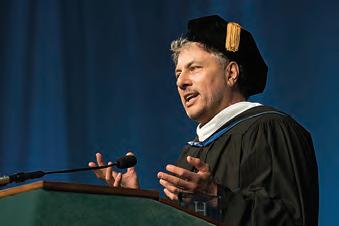
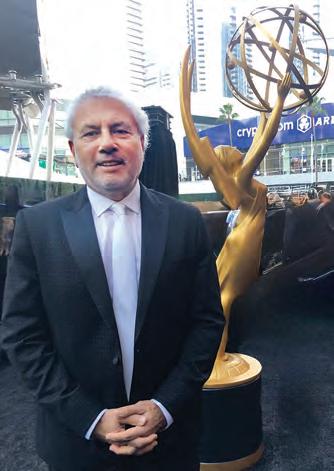
Gary Levine’s public performances and singing didn’t end when he left Binghamton in 1976. He is still a member of his local opera chorus. And for the past 30 years, he has served as the lay cantor for his synagogue in Los Angeles.
“I’ve chanted and led services on Saturdays because I know how to sing,” he says. “That’s an example of life taking a turn that I didn’t expect, thanks to the buffet that a liberal-arts college provides.”
More important, Levine met his wife, Maxine, at Binghamton. They were both living in Hinman College (he was a sophomore; she was a first-year student) and reconnected after going to the same high school. Maxine graduated in 1975.
“We ran into each other, recognized each other, started hanging out — and it hasn’t stopped,” he recalls. “It feels just as vital and wonderful today as it did back in Hinman. She lights up my world.”
Above: Twin Peaks creator and film director David Lynch, left, greets Gary Levine. For Levine’s memories of developing shows such as Twin Peaks and The West Wing, go to Binghamton.edu/magazine.
Left: Gary Levine addresses Harpur College graduates at the 2016 Commencement ceremony in the Events Center.
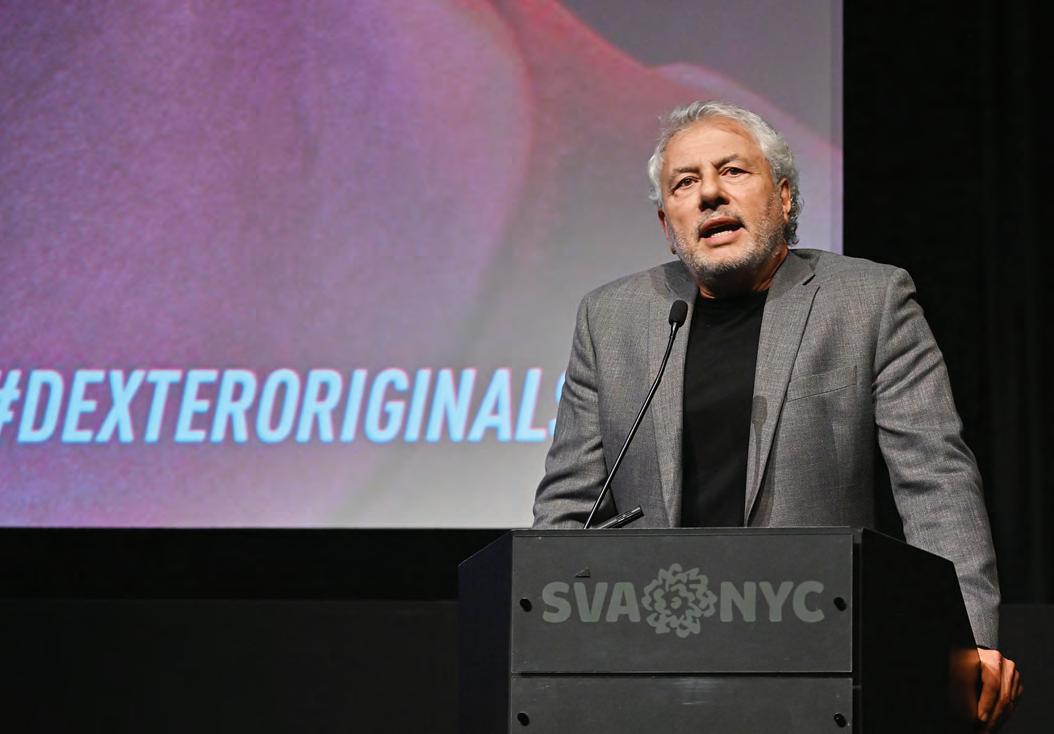
which had long been in the cable-TV shadow of HBO.
“Bringing my creative ambitions to Showtime was appealing,” he says. “HBO had monster hits — The Sopranos, Six Feet Under, Sex in the City. Showtime didn’t really have anything comparable at the time. The freedom and the challenge were irresistible.”
The decision to join Showtime was helped by the presence of thenPresident of Programming Jerry Offsay ’74, who was Levine’s teammate on Binghamton’s freshman basketball team.
“I had to quit [basketball] because it interfered with my theater rehearsals — which Jerry still resents to this day!” Levine says. “When he said: ‘Come put us on the map in series,’ it was an exciting opportunity. It proved to be so exciting that I never left.”
AS EXECUTIVE VICE PRESIDENT OF ORIGINAL PROGRAMMING, Levine’s Showtime hits came quickly: Weeds (about a suburban pot-selling widow)
in 2005; Dexter (a likable serial killer!) in 2006; Californication (an alcoholic novelist moves to L.A.) in 2007; and Nurse Jackie (the show about a drug-addicted ER nurse received 24 Emmy nominations over seven seasons) in 2009. They were followed by hits such as Ray Donovan, The L Word, Billions, Homeland, Shameless, The Affair, The Chi, Yellowjackets and Twin Peaks: The Return. By the mid-2010s, Showtime’s lineup was arguably deeper and more varied than HBO. Levine says the success of Dexter and Weeds (they earned a combined 44 Emmy nominations) made the industry and the public take a new look at the network.
“Those were the two shows that made the statement: We can do high-quality, provocative, entertaining work,” he says. “Showtime started to become a destination for writers who wanted to do those kinds of shows — and for viewers who wanted to see them.”
Levine, who later became president of entertainment at Showtime, did not see “development” as simply accepting a story pitch.
“The beauty of what I got to do was to sit in a room with writers, embrace their idea and then help them shape it into a pilot story and then a pilot script,” he says. “If the pilot script was as good as we hoped and we got the green light for the project, I’d [help] choose a director, a cast, designers, and go shoot it. If the pilot was good, you were off to the races with a series.
“That’s what I treasure more than anything: I was able to win the respect of writers that I respected enormously and help talented people do their best work.”
IN THE PAST COUPLE OF YEARS, the rise of streaming has changed the corporate landscape of television. Showtime is no exception. In 2023, it merged into Paramount Plus, and
Before retiring at the end of July 2025, Gary Levine helped launch two shows from the Dexter world — Dexter: Original Sin and Dexter: Resurrection.
the Showtime streaming app shut down. Then Showtime was removed from the “Paramount Plus Showtime” name. Levine, who shifted into an advisory role, recognized that the time was right to step aside.
“Showtime went from being a premium cable network and streaming service to an option within Paramount Plus,” he says. “There may have been good business decisions for it, but when you’re the guy who spent 20-plus years building Showtime, it hurts.”
But Levine did not leave without taking care of his hits that still reside on Showtime — he oversaw season renewals for Yellowjackets and The Chi, while launching a Dexter prequel (Dexter: Original Sin) and Dexter: Resurrection, a sequel with original show star Michael C. Hall.
Having just begun his retirement, the California-based Levine wants to become more “bicoastal,” as his two daughters live in Brooklyn. That flexibility could also give him an opportunity to visit and work with Binghamton University, says Levine, a member of the Harpur College Advocacy Council who spoke at the 2016 Harpur Commencement ceremony.
Levine says he is proud that his shows will live on and that writers saw him as a partner.
“The beauty of being at Showtime without advertisers and someone checking the ratings every 10 minutes — was that we had the freedom to create a portfolio of shows,” he says. “Every one of them didn’t have to deliver the same things. You could have a niche favorite alongside a show drawing big numbers alongside something getting all kinds of awards. Success could be defined in so many ways. It was an incredible blessing.”

BEHIND THE SCENES OF A CURRENT SUCCESS
ellowjackets, a drama about the aftermath of a plane crash involving a girls’ soccer team, has been one of TV’s biggest hits since debuting on Showtime in 2021. The series, which is Showtime’s second-most streamed show ever (behind Dexter: New Blood), has earned Emmy nominations for outstanding drama and for its writing, casting and acting. The fourth season will begin filming in early 2026 in Vancouver.
“Ashley Lyle and Bart Nickerson made it so real when they pitched it,” Gary Levine recalls. “I said to my colleagues: ‘Is this based on fact?’
We were googling New Jersey high school soccer team catastrophes! That’s how vivid it was. This is an example of being in a pitch meeting and feeling the hairs on your neck go up and getting excited.
“But there was development to do. They originally pitched it with the adults in the 1990s and the high schoolers in the 1970s. We said: ‘Let’s make one of the periods feel like now. Let the high schoolers be in the 1990s and let the present be the present.’ When you’re dealing with talented writers, they take ideas like that and run with them brilliantly.
“The other challenge was that the high schoolers stranded in the Canadian wilderness — with all of the craziness and some cannibalism — is big drama. Could the present day, with the adult survivors, be equally dramatic? The writers were more than up to the task.”
PRESERVING NATURE
Alumni and faculty members form Southern Tier Land Conservancy

By Ethan Knox ’20

hether hiker, hunter, angler or farmer, the Southern Tier offers abundant opportunities for lovers of the outdoors. A walk through a local park — where a new wildflower might be blooming, or a hawk might call overhead — is all it takes to appreciate the beauty of its forests, wetlands and waterways.
But this beauty is fragile. Without thoughtful planning, unplanned development could rapidly erode the very qualities that make the region such a great place to live. Recognizing this risk, a team of Binghamton University alumni and faculty came together to form the Southern Tier Land Conservancy (STLC).
“People often ask why we focus on conservation — after all, there are trees and creeks everywhere around here,” says Jason Shaw ’95, a Broome County legislator and local business owner who serves as the organization’s president. “And it’s true — for decades, our region has seen relatively slow growth, which has helped preserve a lot of natural beauty by default. But that pace could change quickly. As interest in the Southern Tier picks up, we have an opportunity to get ahead of the curve. With thoughtful planning, we can support smart development while also protecting the landscapes and ecosystems that make this place special.”
The nonprofit’s mission is to preserve the area’s natural landscapes, particularly those that are ecologically sensitive. To guide their efforts, the group used a resource inventory created by Julian Shepherd, a Binghamton University professor emeritus of biology, who spent decades identifying the most biologically
significant sites in the region, including unique microenvironments in and around Binghamton.
STLC was founded during the COVID-19 pandemic around a (socially distanced) campfire. The group recognized a gap: While many parts of New York have land trusts — such as the well-established Finger Lakes Land Trust — the Binghamton area had none. Crucial seed funding was provided by the Robert F. Schumann Foundation, established by the sons of local businessman and philanthropist Robert Schumann.
“The Schumann Foundation was instrumental in helping us get this effort off the ground. With their support, we were able to establish ourselves as a group dedicated to identifying land for conservation,” Shaw says. “Those early steps gave us the foundation to approach the New York chapter of the Land Trust Alliance, which helped us develop a strategic plan and move in the right direction. They saw the same need we did.”
The founding STLC team includes Treasurer Jeff Merrill ’94, MA ’99, a natural resource scientist; Secretary Carl Lipo, professor of anthropology and associate dean in Harpur College; and Susan Ryan ’90, a Broome County legislator and lecturer in environmental studies.
“People will say, ‘We need land for development, for housing, for farming,’ and we do,” Merrill says. “But if you look at a map of Broome County, you’ll see how much land is available. You can do both. You can have smart growth. Ultimately, we can find solutions that enable development while also protecting ecologically sensitive areas and preserving open spaces for the benefit of all. We believe our approach will enable our community to thrive — environmentally, economically and socially.”
Jason Shaw ’95 and Susan Ryan ’90 helped establish a nonprofit, Southern Tier Land Conservancy, to preserve the area’s natural landscape. The first acquisition, Canawanna Nature Preserve in Owego, is pictured here.
Notably, STLC’s board represents a range of political perspectives.
“We believe in finding common ground and working with the values of our community,” Ryan says. “People sometimes assume conservation means locking up land and taking away
opportunities. However, our approach can accommodate agriculture, logging and hunting, as well as wildlife, ecological diversity, trails and education.
“The natural beauty of our region is a unifying theme regardless of other differences.”
STLC utilizes a range of tools to accomplish its mission. It is now focused on direct purchases, targeting parcels near existing wild spaces or with rare environmental features. Partner organizations often support these purchases. In time, STLC plans

“One of our goals is to get people to learn how valuable open space is just being there by itself, and that there are impacts associated with agriculture or conservation, but they are minimal compared to the impacts of urban and suburban overdevelopment. The more we can keep those landscapes active — it’s good for our farmers, our food sources, our water quality, our views and so much more.”
— Susan Ryan
to add conservation easements, which allow landowners to retain ownership while giving up development rights.
“It’s not just for the current landowners, but for their kids and grandkids 50 years from now,” Merrill says.

“To make it work in the long run requires legal expertise, strong communication and funding,” Shaw says. “Conservation projects need thousands of dollars each year for insurance, monitoring, legal defense and more.
“When someone puts land into a conservation easement, STLC must plan to monitor it forever,” Shaw adds. “And a future board might have to defend it in court if, say, a neighbor started logging on it. It’s a legally complex, long-term commitment, and there’s a lot more to it than just owning land.”
STLC’s first acquisition was the Canawanna Nature Preserve in Owego, N.Y. — a patchwork of parcels near the confluence of the Susquehanna River and Owego Creek. Once a neighborhood, the area was devastated by the 2011 flood. The Owego Rotary Club had redeveloped the site for outdoor education, but when the land’s owner, Adam Weitsman, offered to donate the parcels, the club needed a partner. Fortunately, the STLC was able to step in.
“Canawanna came along at the right time. Even though the parcels we received from Weitsman were less than three acres in total, they fit into a seven-acre preserve that includes village-owned land,” Shaw says. “It was the perfect place to put everything we’d learned to the test.”
More recently, STLC is partnering with the Upper Susquehanna Coalition to protect nearly 118 acres near Lisle, N.Y., funded by a $334,917 grant from the Susquehanna River Basin Commission. The site features a flood control pond that can hold 20 million gallons of water during storms, thereby reducing downstream flood risk and enhancing water quality. Plans include 19 more acres of wetland, a small parking area, and trails along the East Branch of Nanticoke Creek.
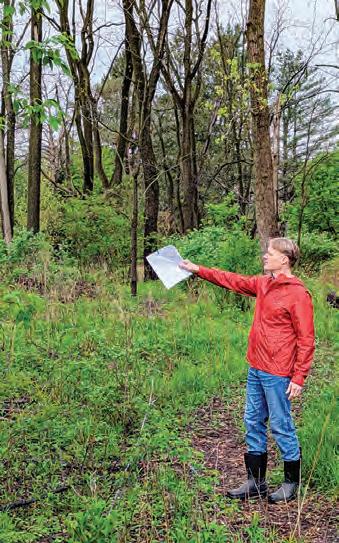
Broome County legislator and business owner Jason Shaw ’95 is president of the Southern Tier Land Conservancy.
These projects reflect some of the most important aims of the STLC: joining fragmented preserves to create larger biodiversity corridors and maintaining balance between industry and nature. But these are just some of the many long-term impacts of the organization.
“One of our goals is to get people to learn how valuable open space is just being there by itself, and that there are impacts associated with agriculture or conservation, but they are minimal compared to the impacts of urban and suburban over-development,” Ryan says. “The more we can keep those landscapes active — it’s good for our farmers, our food sources, our water quality, our views and so much more.”
To learn more about the Southern Tier Land Conservancy’s work or explore conservation options for your own property, visit southerntlc.org.
NEW PRESIDENT IS PRIMED TO LISTEN
Anne D’Alleva is eager to meet the Binghamton University community

By Eric Coker
Anne D’Alleva plans to “hit the ground running” in her first months as Binghamton University president by embarking on a listening tour that will connect her to students, faculty, staff, alumni, industry partners, and local and state leaders.
“I need to get to know the Binghamton community,” says D’Alleva, who started as president on Nov. 1. “I’m calling it a listening tour because I need to hear from people. It’s not about me talking at people. It’s about a dialogue. What do members of our community think is important and special about Binghamton? What are their hopes and dreams for the future of the institution? What are their concerns as we move into the future?
“I very much enjoy engaging with people — and engaging with people in their spaces.”
D’Alleva, who was appointed by the SUNY Board of Trustees in August as Binghamton University’s eighth president, has excelled in engagement as a faculty member and administrator for more than 25 years. She arrives at Binghamton after three years as the University of Connecticut’s provost and executive vice president for academic affairs. D’Alleva, an art historian, also served for seven years as the dean of the School of Fine Arts at UConn.
The quality of Binghamton’s students, faculty and staff, along with state investments and “the dynamism of the SUNY system” drew D’Alleva to the position after Harvey Stenger announced he was stepping down.
“I could see that there was a tremendous sense of collegiality,” says D’Alleva, who recalls being impressed
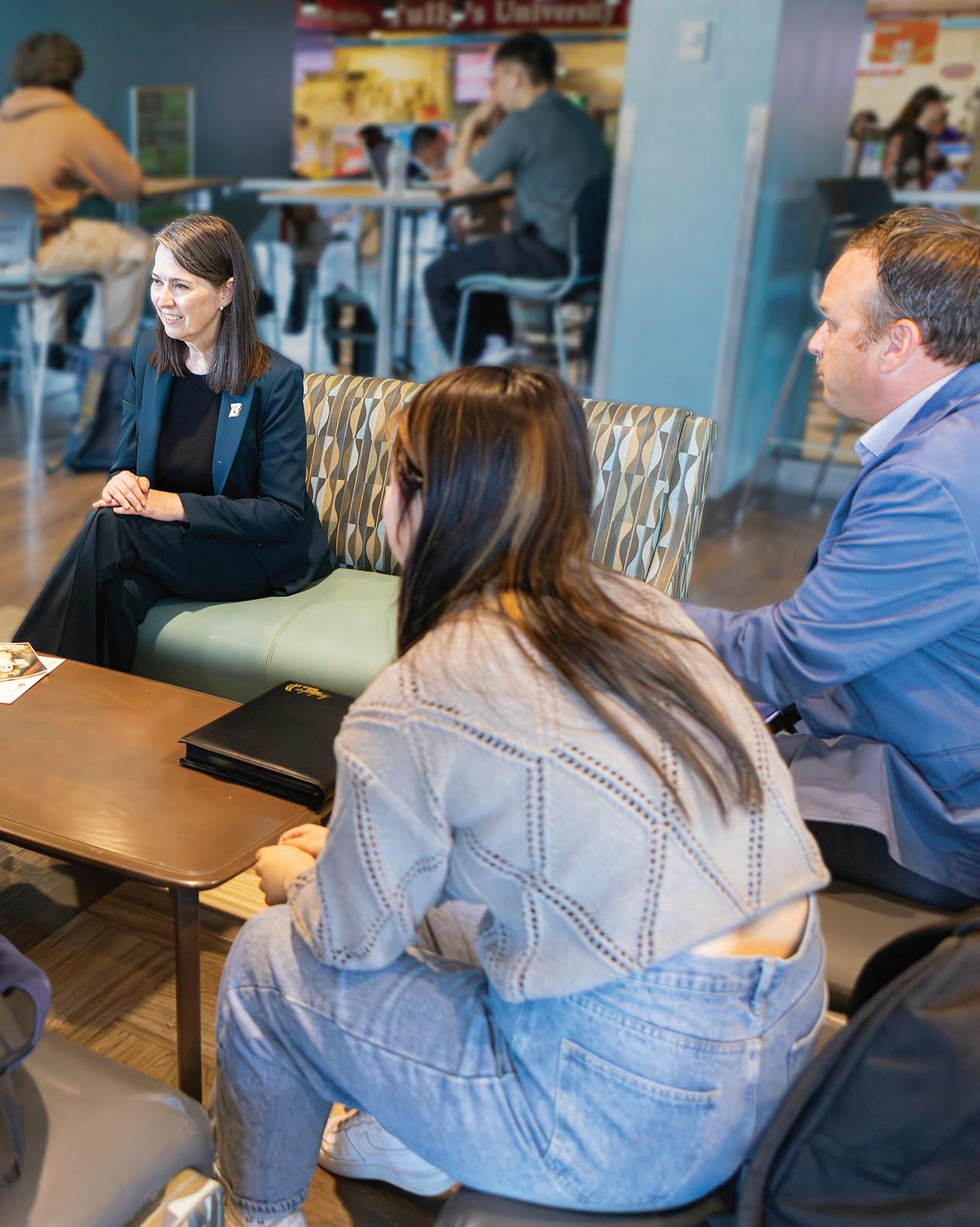
with Binghamton when she delivered a guest lecture on campus in 2011. “People respected each other, got along and collaborated well. In higher education, collaboration is the key to success because of the complexity of our mission.”
It’s a mission that includes shaping the future of a university that has reached new heights in research, scholarship, student success, athletics and economic impact during the past two decades.
“[D’Alleva’s] deep experience, vision, energy and warmth will enable her to build on the foundational successes of Harvey Stenger to new levels of academic excellence and prominence,” says Kathryn Grant Madigan, chair of the Binghamton University Council and the Presidential Search Committee.
For D’Alleva, student success is at the “heart” of what an educational institution does. But the learning and growing experience should be as vital as grades, she says.
“I say ‘heart’ deliberately because we are talking about our students and their lives,” she says. “We need to pay attention to the holistic student experience. If students are struggling to afford tuition, food, housing or transportation — or if they’re not eating well, sleeping enough, connecting socially and feeling that they truly belong — their ability to succeed academically will suffer.”
As UConn provost, D’Alleva established the position of vice provost for student success and also formed a partnership with a food-share program for food pantries on UConn’s seven campuses.
Binghamton University President Anne D’Alleva talks with students in the University Union during a visit to campus in October.
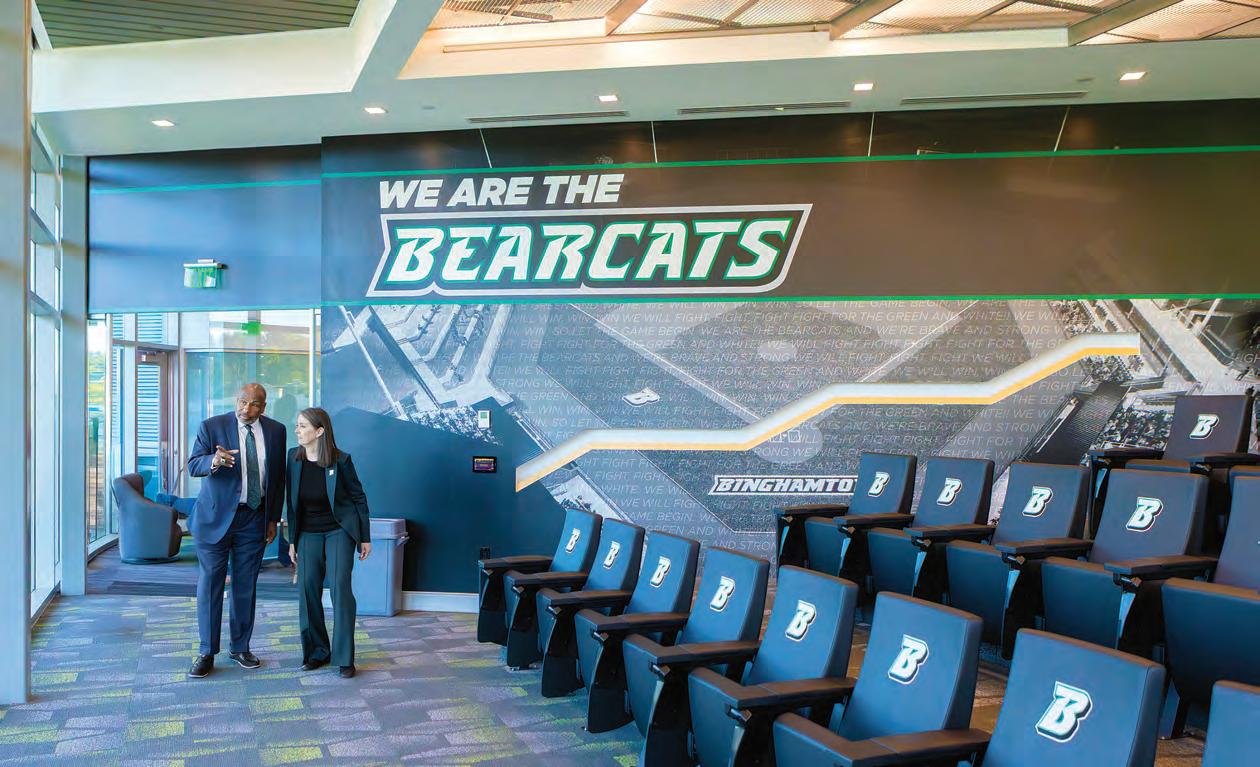
“The ultimate goal is to see our students walking across the stage at graduation and receiving their degrees,” she says. “How we get there is by paying attention to the whole student experience, alongside the classroom experience.”
D’Alleva also values the partnerships of the sciences and humanities. As the UConn dean of fine arts, she helped create the interdisciplinary Krenicki Arts and Engineering Institute.
“When we interconnect arts and sciences, we amplify their impact. I don’t see the humanities, arts and social sciences at odds with the STEM disciplines as an ‘either/or.’ It’s ‘both/and,’” she says. “It’s about collaborating with each other, undertaking innovative interdisciplinary research and teaching. My goal is to ensure that all disciplines that are represented at Binghamton are strong and fulfilling their potential across
teaching, research, economic development and community engagement.”
Alumni engagement is a third area that D’Alleva believes is essential to Binghamton’s success. More than 160,000 strong, Binghamton graduates can be champions for the University by serving as mentors, sponsoring internships, giving a guest lecture in a class, or by simply wearing a Bearcats sweatshirt, D’Alleva says.
“So many of our alumni have very high satisfaction with their Binghamton experience,” she adds. “They credit their success in their lives and careers to Binghamton. So, we need to ask our alumni to stay involved and pay it forward: Make that transformative educational experience possible for another generation of students.”
D’Alleva also praised Binghamton’s role in the SUNY system and the leadership of Chancellor John King Jr.
“He brings a unique understanding
of the state and national educational landscape,” D’Alleva says of King. “He’s been dynamic and creative, and is increasing the national prominence of the SUNY system and its individual campuses. SUNY is, and will continue to be, one of the most important higher-education systems in the country.”
D’Alleva describes herself as a “servant leader” who brings an “attitude of openness and respect for others” to her work and drives transformational change.
Those leadership traits will be on display during the Listening to Lead Tour: Charting the Path Ahead, as D’Alleva plans to spend November to early 2026 holding a variety of in-person and virtual events. A website of listening-tour content is scheduled, followed by the launch of a new strategic planning process in the spring 2026 semester. The plan
Anne D’Alleva tours the Baseball Complex with Director of Athletics Eugene Marshall Jr. in October. D’Alleva started as University president on Nov. 1.
QUICK HITS
Q: How did you get into art history?
A: “One of my very earliest memories is of being in a stroller in a museum and my mother pointing out the paintings to me. I grew up in a family that very much appreciated the arts, but I didn’t go to college thinking I was going to be an art historian. When I took an art history class as a general-education requirement my freshman year, I fell in love with the discipline and decided that was what I wanted to study. My story is a lesson about the power of general education to open up possibilities for students as they come into the university.”
Q: Do you have a favorite museum?
A: The Metropolitan Museum of Art: “It’s the museum I grew up going to most often. There is always something to see there that’s new and interesting. They do a phenomenal job both with their permanent and temporary exhibitions. The Met is near and dear to my heart, but I enjoy exploring all different kinds of museums.”
Q: What are your hobbies and interests when you are not working?
A: “I love going to museums and also the performing arts. I enjoy gardening, too — both flower gardening and vegetable gardening. We did some experimenting with heirloom zucchini and tomato varieties
this past summer with mixed success. And I like to cook, both traditional recipes from my Italian family, as well as new ones that I learn from cookbooks or cooking classes.”
Q: What are some books you’ve recently read that you recommend?
A: “This summer I read The Underground Railroad (2016) by Colson Whitehead. I hadn’t gotten around to reading it until now because it came out when my children were young and I had just started as dean of fine arts at UConn, so my reading time was very limited. Over this past winter I had read James (2024) by Percival Everett, which is what brought The Underground Railroad to mind. Both are powerful reinventions of, and reflections on, the Black experience. I also just read Isola (2025) by Allegra Goodman, an extraordinarily inventive novel that uses two very brief 16th-century texts to reimagine the life of a French noblewoman abandoned on an island in the Gulf of St. Lawrence.”

will be ready for implementation in fall 2026 as the University observes its 80th anniversary.
“It will be a great way to mark that turn toward the future — both celebrating and assessing what we’ve done in the past 80 years and thinking about what the [future] might look like,” she says.
“When people ask: What are the top public universities in the country? When they talk about Cal-Berkeley, Michigan and the University of Virginia, I want them to be talking about Binghamton in the same breath. When there is a national conversation about critical issues in higher education, I want people to say: Binghamton needs to be at the table. … That’s the ambition. That’s the goal.”
D’Alleva says she is “all in” on Binghamton University and is eager to meet with its community.
“I am so excited and honored to be leading this institution,” she says. “There is a great future ahead of us. There will be challenges along the way, but what you will learn is that I am not only an energetic and hardworking person, I’m also a resilient and endlessly optimistic person. And one of the things I’m very optimistic about is Binghamton.”
Q: What is it about the Northeast that you still love?
A: “I love the cultural and economic dynamism of the Northeast. I also appreciate the region’s inclusiveness and openness. The natural beauty of upstate New York is absolutely breathtaking. I’m excited to be based here.”
THE D’ALLEVA FILE
■ Born in the Bronx and raised in Pelham, N.Y.
■ Bachelor’s degree in art history from Harvard University.
■ Master’s degree and doctorate in art history from Columbia University.
■ Joined the University of Connecticut faculty in 1999 as a joint appointment in art history and women’s studies. Before her arrival at UConn, she completed postdoctoral fellowships at the Australian National University and the Getty Foundation and taught for two years at the University of St. Thomas in St. Paul, Minn.
■ Dean of UConn’s School of Fine Arts, 2015–22.
■ Provost and executive vice president for academic affairs at UConn since 2022. She was the first woman to serve as provost at the university.
■ Books include Fundamentals of Art History and Methods and Theories of Art History.
Veterans days
Binghamton University’s military connection was established well before the academic institution opened as Triple Cities College in fall 1946.
In 1942, future Founding President Glenn G. Bartle left his dean’s position at the University of Kansas City to join the U.S. Navy during World War II. The following year, Bartle was sent to Swarthmore College in Pennsylvania to lead a unit in the V-12 Navy College Training Program, designed to meet the Navy’s need for commissioned officers. The seamen and college made an impression on Bartle.
“When I took the job in Binghamton, I had in the back of my mind that we wanted to make a school with a standing comparable to Swarthmore,” Bartle says in the book Harpur College in the Bartle Era by Stephen McIntire.
Triple Cities College/Harpur College was one of the schools established after World War II with a mission to educate returning veterans. Nearly 80 years later, Binghamton University still has an Office of Veteran and Military Services that serves and assists student veterans and military dependents, and it is a satellite school for Cornell University’s Reserve Officers’ Training Corps (ROTC).
The following pages feature three examples of alumni veterans or alumni who work with veterans. U.S. Rep. Eugene Vindman ’97 is one of three Binghamton alumni now serving in Congress; Tuesday Brooks ’85 is a business leader who has returned to campus to speak as a veteran; and former student-athlete Allison Goldman ’00 is using her sport, tennis, to assist veterans.


Binghamton, the military and public service
All have been vital to U.S. Congressman Eugene Vindman
By Eric Coker
For U.S. Rep. Eugene Vindman ’97, the journey to the U.S. Congress started as a history student and ROTC (Reserve Officers’ Training Corps) member at Binghamton University. After graduating, Vindman — who came to the U.S. from Ukraine with his family as a child — spent 25 years in the U.S. Army as a paratrooper, infantry officer and a Judge Advocate General’s Corps (JAG) officer. He also served in the Iraq War.
Vindman — whose twin brother Alexander is a 1998 Binghamton graduate — retired from the Army in 2022. In Washington, D.C., Vindman was a deputy legal adviser to the National Security Council and the NSC’s senior ethics official in the White House, where he had a role in the first Trump impeachment case. In 2024, Vindman ran for Congress in Virginia’s 7th Congressional District. He defeated Republican and fellow veteran Derrick Anderson in the November election and is now a member of the U.S. House Committee on Agriculture and the U.S. Armed Services Committee. He and his wife, Cindy, who he met at Binghamton, have raised their son and daughter in Dale City, Va.
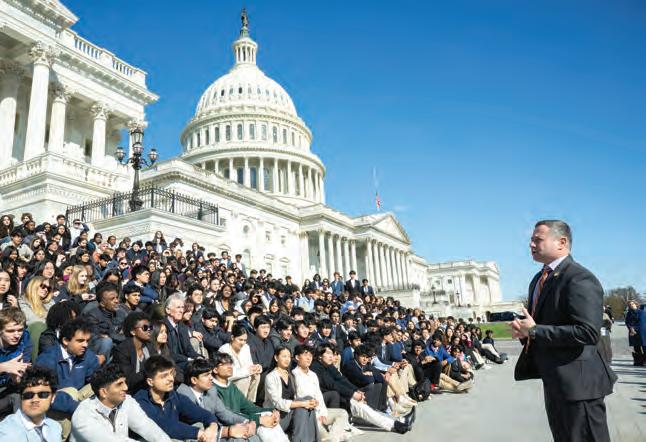
Question: What made you decide to attend Binghamton University and major in history?
Answer: I viewed Binghamton as the Ivy League of the SUNY schools in New York state. It came down to Binghamton and another school, but a particular data point convinced me to choose Binghamton — and I couldn’t have made a better decision. I’ve always been a history buff and an avid reader, so I pursued that passion there, and I still hear such incredible things about all the opportunities it offers students today.
Q: How did being a part of ROTC in college affect your decision to join the U.S. Army?
A: ROTC gave me my first real introduction to the military — to wearing the uniform, developing technical proficiency and embracing the values that define service. Over time, I grew to love the organization, the meaningful work I was doing and, most of all, the people I had the privilege to work alongside.
Q: What are some of your memories from your quarter-century serving in the U.S. military?
A: I remember my jumps from airplanes and my deployment to Iraq. I think back to my first position as a platoon leader — I had a great platoon. I was just 23, fresh out of college, leading 39 people in the 82nd Airborne Division at Fort Bragg. I also had an interesting job at the White House on the National Security Council, which I’m sure no one has heard anything about …
Q: You and your brothers all served in the military. What does service mean to your family? Can you speak to that experience?
A: As immigrants, we were deeply grateful to this country for welcoming us as refugees. For me and my brothers, serving in the military was our way of giving back to the nation that gave us so much. My wife also served, and together we’ve shared in the experiences, sacrifices and sense of purpose that come with wearing the uniform.
U.S. Rep. Eugene Vindman ’97 speaks to a group of visitors outside the U.S. Capitol.
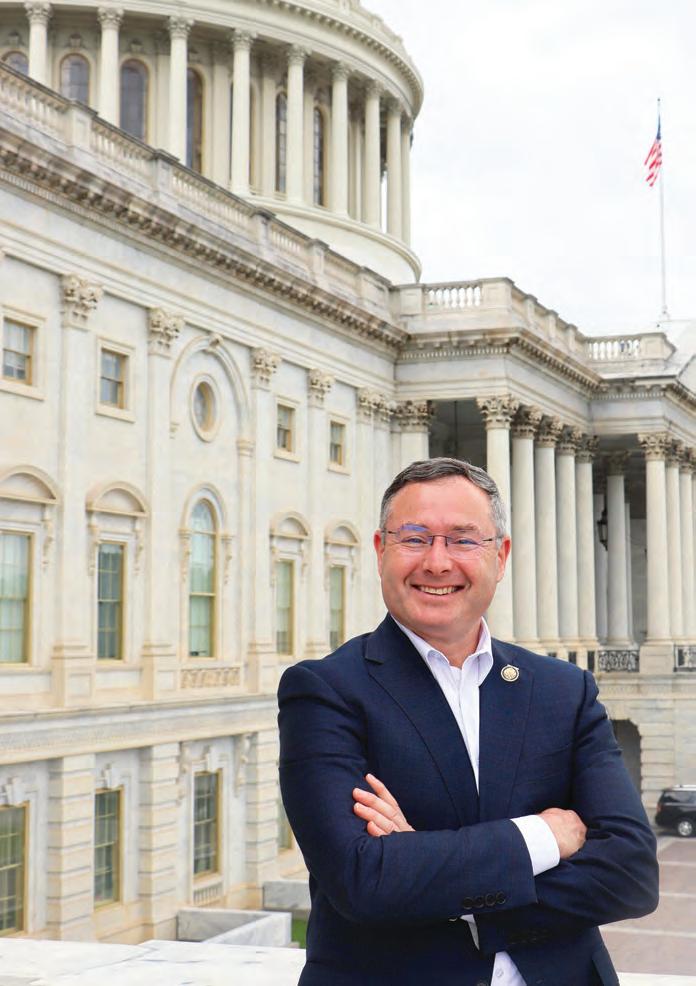
Q: As a congressman, you remain actively involved with veterans and Virginians across the country. Why is that important to you?
A: These are my brothers and sisters — people I served with for decades across all branches of the military. I know the sacrifices veterans and their families make, and I understand the solemn promise this country makes to care for them in return for all they’ve given. I will always fight for the 72,000 veterans who call Virginia’s 7th District home — and the millions scattered across the United States and the world.
Q: What are some of the key challenges still facing veterans in the U.S., and what can we do to help?
A: Right now, this administration is cutting resources to the VA and imposing hiring freezes that are straining veterans’ health facilities — including the largest one in the country, right here in Virginia’s 7th District. Limited access to specialty care remains a serious challenge and, too often, veterans face conditions that civilian providers and the general public don’t fully understand, including post-traumatic stress. As a member of the House Armed Services
Committee, I’m working each day to ensure our veterans receive the care, support and respect they’ve earned.
Q: Why is public service, in the military, politics, education, health, etc., so vital to our nation’s well-being?
A: It’s selfless service — service to our community and our fellow Americans. It unifies people from different walks of life, of all colors, creeds and cultural backgrounds. It’s a way for Americans to come together.
Q: What did you learn from your time at Binghamton and your military experience?
A: I learned the value of a good education. I built friendships and relationships that have spanned decades — including meeting the love of my life, Cindy. I also learned the value of hard work. Earning a degree from Binghamton, such a great institution, required dedication and discipline. In fact, there are three current members of Congress who are Binghamton grads — House Minority Leader Hakeem Jeffries, Congressman John Mannion and me. We like to jokingly call ourselves the “Binghamton Caucus.”
Q: What would you say to young men and women thinking about joining the U.S. military?
A: I’d say go for it. Choosing to serve in uniform is one of the highest forms of public service — a commitment to your country and to something far greater than yourself. The opportunities, experiences and relationships you gain are invaluable, and they build a foundation of discipline, leadership and purpose that will serve you throughout your life, whether your goals are continuing your education, pursuing another career or staying in public service.
Putting veterans on center court
Allison Goldman uses the power of tennis to help change lives
By Eric Butterman
Back and forth. Back and forth.
Pain can be like that; it can come and go. And with tennis, at least for a little while, the pain can go. Allison Goldman ’00, once a varsity tennis player for Binghamton University, knows that. Since her father first put a racket in her hands at the age of 3, and later coming back from an illness that once rendered her unable to walk, tennis helped push her forward not just physically, but mentally.
People suggested to Goldman that maybe it could do the same for veterans.
With that urging, Goldman co-founded Tennis Serving Vets in 2018, a place for veterans to create community and play tennis for growth in physical and mental health — and patrons are never charged a dime.
“The first event at the Yonkers Tennis Center had about 50 to 70 attendees. It was an unbelievable response,” says Goldman, who is also executive director of the organization. “People were incredibly excited to play. Their problems would sometimes melt away for a bit. They could just focus on tennis.”
Even simply attending the event could help. Some veterans had been housebound, but Goldman said that being around people or cheering them on in a match could make a big difference.
Goldman has seen the effect of the organization on the social, physical and mental health of individuals served. In one case, it even put a roof over someone’s head.

“We had one veteran who had been coming around and was homeless,” she says. “I got to know him, and eventually he asked me for help. We were able to connect him with someone who helped find him a place. It’s all about connections and community.”
Tennis Serving Vets also partners with an organization called HERO INC. The mission of HERO INC. is to provide quality recreation for all people with disabilities.
The tennis gatherings, which usually have around 20 to 30 people, take place once a week during the better tennis-weather months, and once to twice a month otherwise.
Outdoor tennis gatherings are now at Anthony F. Veteran Park in the Westchester (N.Y.) town of Ardsley, and in winter 2024, veterans played at Greenburgh Indoor Tennis in White Plains.
“People were incredibly excited to play. Their problems would sometimes melt away for a bit. They could just focus on tennis.”
— Allison Goldman
Tennis Serving Vets and HERO INC. even take the veterans to the biggest tennis event in the country.
Goldman, who worked for many years at the United States Tennis Association (USTA) and USTA Eastern, has been able, through her connections, to take veterans to the U.S. Open every year — but not just to watch.
Veterans have been able to play at Arthur Ashe Stadium in Queens, N.Y., thanks to Tennis Serving Vets.
“Veterans get to take center court on Arthur Ashe Stadium and play, and the crowd goes crazy for them,” she says. “It shows them that they haven’t been forgotten. And what could be better for one of the great sporting events in the U.S. than to have U.S. veterans? It’s a beautiful fit.”
It’s also special for Goldman to share the U.S. Open with the veterans, as she has attended the event personally for many years, she says. The only U.S. Opens she has missed were between 1996 and 2000, because she had to get back to Binghamton to prepare for the upcoming collegiate tennis season.
“Living in the New York City area, it’s such a special event that takes over the city and gets tennis on everyone’s brain,” she says. “To see veterans take in the experience, to feel the energy, I love sharing it with them. We all bond over it.”
Goldman has been able to attract other supporters for the organization. From Whole Foods supplying treats to events to the Good Dog Foundation bringing canines to interact with veterans, the sponsor response has been strong. Goldman is good at connecting for a cause, partly from her previous experience working with the USTA Foundation on its annual U.S. Open Pro-Am, a special fundraising event that occurs during and on-site at the U.S. Open. The Pro-Am allows for players who donate to the cause to be placed on-court with famous tennis players. The fundraising proceeds help people play tennis throughout the country.
It is Goldman’s hope for Tennis Serving Vets to be mimicked regionally or nationally — and it doesn’t have to be reserved for tennis.
“It could be another sport which organizers are interested in,” she says. “It’s just about getting veterans the connections they need and deserve. They stood up for us. We need to stand up for them.”
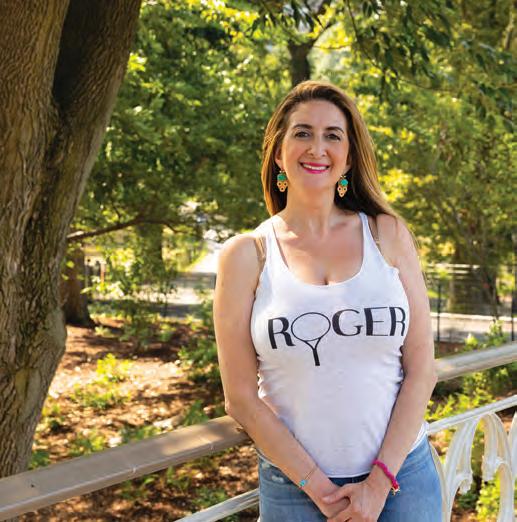
Sharing the game with veterans means the world to Goldman, because tennis has always been a huge part of her life.
“I was very short, and my opponents were usually really tall,” she says. “Some of my on-court strategy was to rely on shots like my low backhand slice, which gave them lots of trouble and threw off their rhythm. I also loved to hit the ball with a lot of pace off of both my backhand and forehand sides. But you can’t win solely with pace; you have to throw in other types of shots to mix up the game.
“The game of tennis has you always thinking, always playing moves ahead. That’s part of how it can provide a distraction for veterans from problems, at least for a little while. I loved the feeling of playing in junior events since I was about 7 years old. You end up thinking about the game while you’re eating dinner!”
And the experiences stay with you as it did with her, she says.
“I think about my matches and experiences from Binghamton varsity every day: the people I was able to play with and the challenge of
Allison Goldman ’00, a former Binghamton tennis player, leads Tennis Serving Vets.
fitting it with your studies,” she says. “I remember studying in between matches and how you balanced everything. You had to miss some social events sometimes, but those sacrifices are necessary to play varsity college tennis. I wouldn’t trade it for anything. I loved it.”
Goldman gives her time to Tennis Serving Vets for free. So it shouldn’t be a shock that her job, presently director of business development, U.S. territory, on contract with VTEC Tennis Esports, is for a company that has a virtual-reality product for tennis.
“I just can’t seem to get away from the game — and I don’t want to,” she says with a laugh. “Beyond winning tournaments or titles, or even being a great player, it’s about community, it’s about being active, it’s about something you can do for the rest of your life. We have people playing through Tennis Serving Vets that were in the Korean War. We get done with an event and, if we still have court time, they’re out there loving it. It’s not just about winning for them; it’s about wanting to play. I know the feeling!”
Alumna veteran travels ‘winding road’ to success
Tuesday P. Brooks is a leader in business and the military
By Jen A. Miller
Tuesday P. Brooks ’85 came to Binghamton University intending to major in accounting, so it would make sense that she is also the founder of AJOY, a New York Citybased financial management firm with a focus on tax accounting for women-led businesses.
But it took a change in major — and a few post-Binghamton years — to get there.
“It was a crisscrossing, winding road,” says the U.S. Army veteran with a laugh. She doesn’t see it as a set of detours, but a set of experiences that brought her to the right place at the right time.
Brooks graduated at 16 from Murry Bergtraum High School for Business Careers, a career-focused high school where all students had to declare a major. She picked accounting and enjoyed it, so becoming an accounting major at Binghamton seemed like a natural choice.
But when Brooks started college, she realized it wasn’t a good fit for her at that point in her life. She had performed as a child (a run that included winning the first Harlem Mini Miss Pageant in New York City and training in drama dance with actress Eartha Kitt) and thought: “Why wouldn’t I just do what I love?” So, Brooks switched her major to theatre, studying under Broadway playwright and Professor Loften Mitchell, and even performed in an off-campus production of Samm-Art Williams’ Home
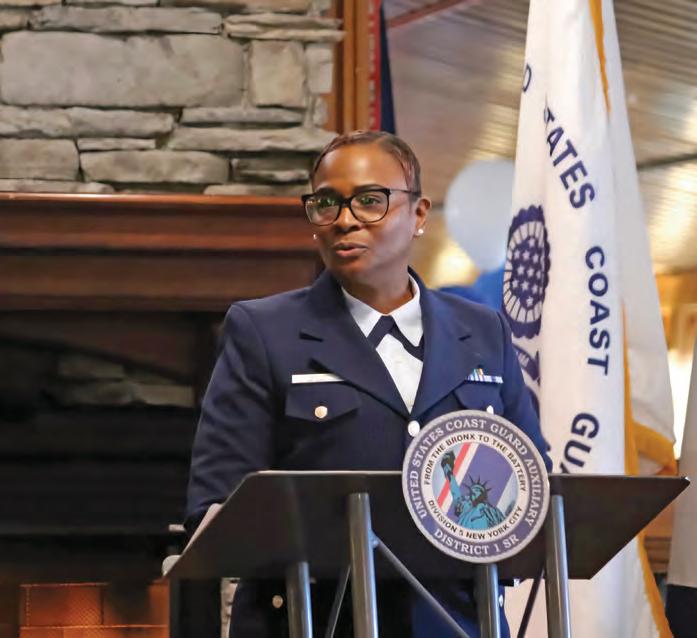
In her sophomore year, Brooks also enlisted in the U.S. Army Reserve and spent her college summers shuttling between New York and Fort Jackson, S.C., for training.
She served as a reservist for six years, working in the maintenance section of her unit as a primary driver, particularly on convoys. In that role, she drove 5-ton trucks that carried equipment, supplies
and soldiers. One summer, she drove from the Bronx to Baltimore to load trucks onto ships being taken to the Netherlands, which also meant a trip to Amsterdam for her.
At the same time, Brooks was working as a commercial actress, and had some success. But after a few years in front of the camera, her heart wasn’t in it anymore. She shifted gears and got her master’s
Tuesday P. Brooks ’85 is commander of the Lower Manhattan Flotilla of the U.S. Coast Guard Auxiliary.
degree in education from Columbia University, after which she taught incarcerated young men at the Rikers Island Educational Facility, and then at an alternative school for students ages 19 to 23 working toward a traditional high school diploma.
She took that experience as an educator to work for the public education office, which was established in 1991 when a construction project in Lower Manhattan uncovered what’s now known as the African Burial Ground National Monument. It’s a site where thousands of Africans — many of whom had been enslaved — were buried during the late 17th and 18th centuries. Brooks did administrative work for the office and trained public educators who went into schools and organizations across New York City to teach people about the site and its significance.
That experience opened the door once again for her original high school interest in business and management. In 1995, she opened the first iteration of AJOY (then focused on business management). Brooks also worked for other companies under that umbrella, including for a venture capital firm and a boutique CPA firm.
Working for the CPA revived her interest in accounting, as she could see the benefits of accurate and timely bookkeeping.
“I learned about tax compliance and then was able to see what business owners were lacking,” says Brooks, who received her MBA from the Metropolitan College of New York.
Brooks knew she could help more people if she shifted her focus to tax accounting for small businesses. In 2009, she relaunched AJOY.
“I already had the skill set. I thought: ‘This is perfect, I’m going to do this for the types of small businesses we’re working with,’” Brooks says.
Today, the financial management services firm offers tax accounting for small businesses, with a focus on
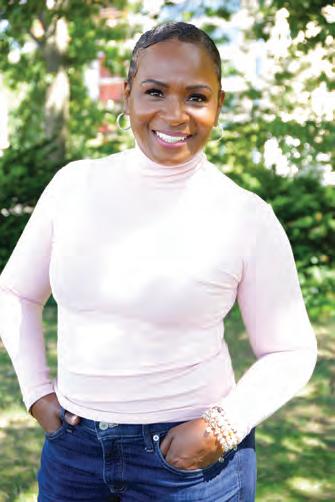
“The opportunities that came to me while at Binghamton actuated who I became as a doer.”
— Tuesday P. Brooks
helping clients create effective cash management and profit strategies that allow them to grow. The firm is also women-powered and women-focused. While AJOY doesn’t exclude men or male-run businesses, Brooks says the company seeks out and markets to women “because it is who we do our best work with, and it’s women who appreciate what we do most.”
Brooks says her experiences at Binghamton set her on the path to where she is today, because her time there was both an academic challenge and gave her valuable life skills. When she arrived, she immersed herself in campus life.
“It truly became a home away from home,” she says.
Over her time in college, she helped charter the undergraduate chapter of Alpha Kappa Alpha Sorority Inc. on campus; became active in the Black Student Union; and served as a counselor with Binghamton’s Educational Opportunity Program (EOP). She also had to juggle her extracurriculars with coursework and Army duties.
“I learned how to manage all of that,” she says. “The opportunities that came to me while at Binghamton actuated who I became as a doer.”
Her time in the Army left such an impact that she’s still involved today with the military as commander of the Lower Manhattan Flotilla of the U.S. Coast Guard Auxiliary, one of the oldest and largest flotillas in the U.S. Northeast Southern Region District. It’s an all-volunteer organization that’s a “force multiplier” for the U.S. Coast Guard. Its primary focus is on boating and marine safety, but it also helps with a range of other duties, including air rescue, container inspections, vessel safety checks, and even cooking for and feeding “coasties” when Coast Guard ships come into New York.
Brooks has also returned to Binghamton in recent years to take part in an alumni veteran panel and speak at the University’s annual Veterans Day flag-raising ceremony.
Brooks ties her Coast Guard Auxiliary work back to the importance of service, which she learned at Binghamton. She also credits Binghamton for her military service, because she wouldn’t have enlisted in the U.S. Army Reserve if she had not been introduced to the idea while in college.
“I didn’t realize it until recently: Service is how I move through the world, and it’s what brings me joy,” she says. “From the military to my sorority to running a business, every part of my life is rooted in showing up for others.”
ALUMNA KEEPS THINGS MOVING AT JFK AIRPORT

In her urban and regional planning course, Margarita Potapova ’20, MPA ’22, was tasked with reimagining the site of the former Johnson City High School, a blighted property slated for transformation into apartments.
The assignment sparked her passion for urban planning, providing an “aha” moment pointing toward a career path.
With the desire to make meaningful impact, she serves as landside contract manager at John F. Kennedy International Airport in Queens, N.Y.
“My primary focus is resource management, ensuring we have enough parking space and strategically
deploying support staff to meet demand,” Potapova says. “It’s a lot to juggle, but that’s what makes it exciting.”
With a passenger volume that averages nearly 175,000 per day, the job is challenging under normal conditions. The airport’s current $19 billion redevelopment project adds another layer of complexity.
“With new terminals, improved ground transportation and expanded taxiways and gate capacity, the entire landscape is in constant flux,” Potapova says. “I work with landside staff and contractors to predict and control
parking usage. The parking landscape changes almost weekly — affecting capacity and where passengers park. It’s not just predicting where they park, but also managing their behavior.”
Potapova says it’s exciting to see the results of her work.
“I get to step into the field and witness firsthand how projects I’ve worked on are impacting the way people move through our spaces. There’s a deep sense of satisfaction knowing that the work I do today will help shape the future of the airport for years to come.” — STEVE SEEPERSAUD

1962
David Segal ’62 shares that the U.S. Military Academy at West Point established the David and Mady Segal Military Sociology Consortium, a forum for teaching and research collaboration among sociology faculty members.
1963
Forrest Greenslade ’63 wrote Animal Farm: The Rest of the Story (Newman Springs, 2025).
1972
David M. Gold ’72 wrote Democracy and the Courts: The Rise of Judicial Elections in the Antebellum South (University of South Carolina Press, 2025), the first comprehensive exploration of the advent of this often-controversial democratic reform in the 19th-century American South.
Barry Marcus ’72 is a retired geologist in Sacramento, Calif. He retired from a career as a local government regulator with the Sacramento County Environmental Management Department. His memoir, Dead Man Squawking, provides a colorful background to life at SUNY Binghamton in the late 1960s and early 1970s.
Richard Martin ’72 is a widely published poet. Another Chicago Magazine (ACM), an online literary magazine, published an interview with him in February 2025. He founded the Big Horror Poetry Series (Binghamton, 1983–96) and is a retired Boston Public Schools principal.
Susan Trevizo ’72 (as Sonya Trevizo) wrote her comingof-age memoir, The Education of a Musician’s Daughter (Austin Macauley, 2025). The book includes several chapters about SUNY Binghamton from 1967–72.
1973
Steven Ratiner ’73 published Grief’s Apostrophe (Beltway Editions, 2025), a poetry collection touching on personal loss, societal grief and the way we use language and art to take steps toward healing.
1976
Santosh Ghosh, PhD ’76, wrote Deep Time: Earth’s Geologic Journey from Eternity to Homo Sapiens (Earth’s Journey Storyworks, 2025), a narrative tracing the planet’s 4.6-billion-year journey, from its fiery beginnings to the emergence of humans.
Vincent Scarsella ’76 has ventured into screenwriting and indie filmmaking. He co-wrote the feature film One of the Good Ones, recently filmed in Buffalo.
1977
Ellyn Merriam Siskind ’77 has been happily married to Andy Siskind ’75 for almost 50 years! She retired from teaching high school Spanish in 2018 and has become an avid birder. Andy retired as a professor of medicine in 2021.
1981
Sharon Kahn ’81 wrote They Validate Your Parking, Not Your Feelings: A schnook’s guide to cataracts (The Authors Point, 2025). Kahn, a psychologist, explains the ways of surgeons to humans.
1985
Ellen (Popolizio) Hernandez ’85, MAT ’87, is a retired English professor and freelance writer. She published the third edition of her textbook, Writing for All (Cognella, Inc., 2024).
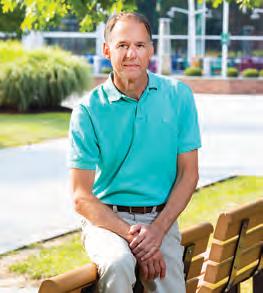
David Skyrca ’85, art director in the Division of Communications and Marketing at Binghamton University, has reached his 40th year of employment with the University. He recently received two professional service awards: the Peer Recognition of Outstanding Professional Service (PROPS) Award and the University STAR Award. He also received three Best of Category awards for graphic design work in the SUNYCUAD 2025 Awards for Excellence.
ALUMNUS/CEO IS FIGHTING CLIMATE CHANGE
ABinghamton alumnus is leading LSB’s effort to be a leader in energy transition in the chemical industry.
Mark Behrman ’84, CEO and board chairman of this Oklahoma-based company (NYSE: LXU), is focused on reducing the carbon footprint in its manufacturing processes.
Take, for example, ammonia. Its manufacturing process usually releases tremendous amounts of carbon dioxide (CO2) into the air. LSB is developing a project at its site in El Dorado, Ark., that will sequester about 400,000 tons per year of CO2 and store it permanently in the ground. This will not only reduce the company’s annual CO2 emissions, but also allow it to produce low carbon or “blue” ammonia and other related products that can be sold to customers at a premium.

“ It’s all about the people — the teams you build and the cohesiveness you have.”
— Mark Behrman
“Climate change was the initial reason for doing this,” Behrman says. “We know the climate’s getting warmer, and that weather patterns are more erratic around the world. We think our process to decarbonize is good for the environment and for all our stakeholders.”
Behrman joined the company following a career in investment banking, during which he worked with companies such as LSB. He started in corporate development before becoming chief financial officer and then rising to his current position. When asked what he’s most proud of, the answer isn’t tied to financial performance, even though he led the effort to turn around and stabilize the company.
“It’s all about the people — the teams you build and the cohesiveness you have,” Behrman says. “You can build a brand-new ammonia plant and spend $4 billion doing it, but if you don’t have the right people to operate and maintain it, you’ll be very inefficient and unreliable. When I first took over the company, I said it’s all about the people, and my management team laughed. Seven years later, I don’t have to say it anymore. They’ve all bought in.” — STEVE SEEPERSAUD
1988
Adam L. Browser ’88 joined Forchelli Deegan Terrana LLP as partner in the firm’s construction practice group. He earned his juris doctor degree from the Maurice A. Deane School of Law at Hofstra University.
Thomas Tolentino ’88 is board president for the Angel Island Immigration Station Foundation, which raises awareness of the history of Asian immigrants excluded and detained at Angel Island (California) from 1910–40.
1989
Arthur Frankel ’89 published two articles in the journal Modern Pathology: “Machine learning for rhabdomyosarcoma histopathology” and “Toward deploying a deep learning model for diagnosis of rhabdomyosarcoma.”
Stuart Hurowitz ’89 was sworn in as an associate justice of the District Court by Massachusetts Gov. Maura Healey on Dec. 4, 2024.
Russ Nelligan ’89 was promoted to corporate vice president of marketing for Hearst Television. He moved to Hearst headquarters in New York from WCVB-TV in Boston, where he was creative services director for the company’s flagship station.
Q&A with a U.N. legal officer
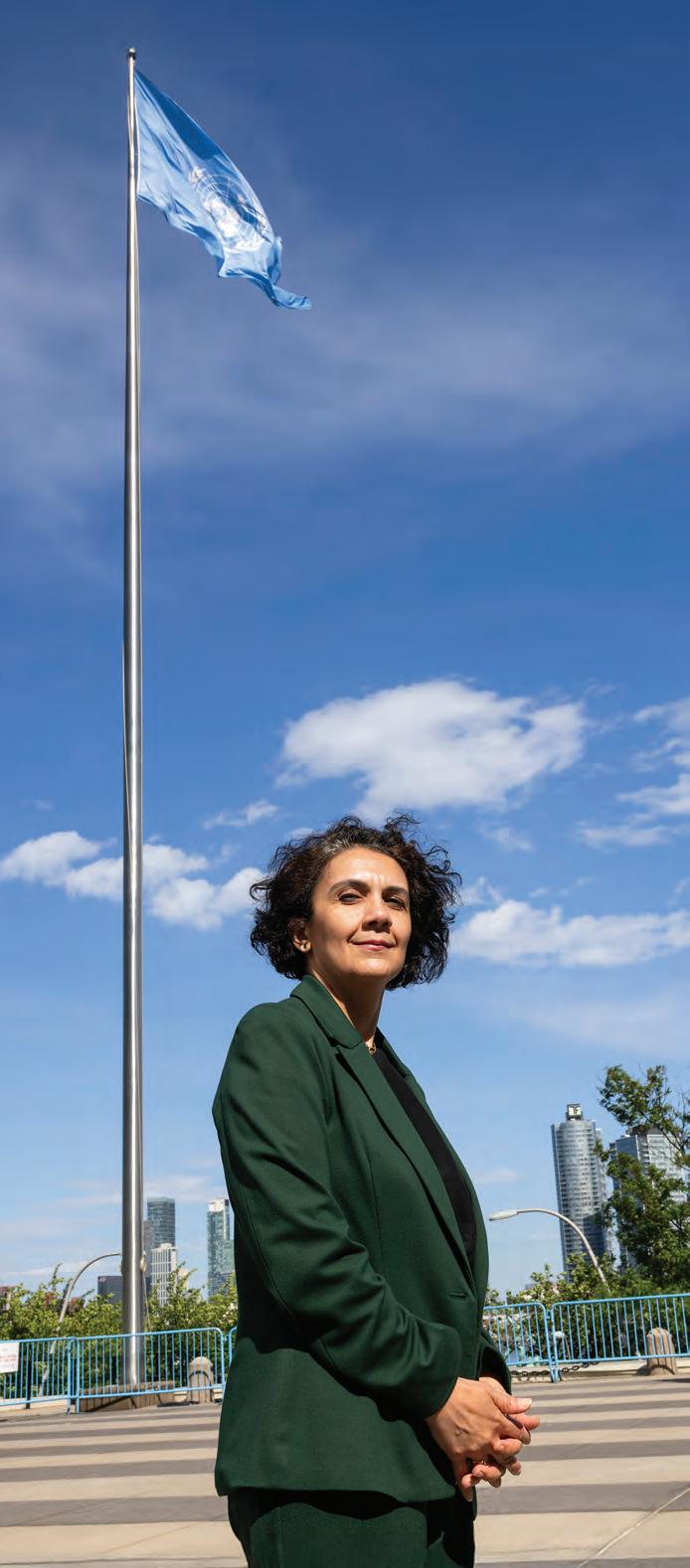
MARYAM KAMALI ’90 works at the United Nations’ New York headquarters as a legal officer, providing centralized legal service to various departments and offices within the U.N. Secretariat, as well as funds and programs, such as the United Nations Development Programme and UNICEF.
Q: What are you responsible for in your present role?
A: I review, negotiate and enter into a range of legal agreements and instruments between the U.N., the private sector and governments for contributions, intellectual property and special events occurring at the U.N. The role is a bit like being in-house counsel at a big firm.
Q: What did you do before this position?
A: I was an associate legal officer with the U.N. Compensation Commission in Geneva, created in the aftermath of Iraq’s 1991 invasion of Kuwait. I reviewed claims arising from Iraq’s invasion, including environmental claims by neighboring countries.
Q: What accomplishments are you most proud of?
A: I’ve been able to help the world’s most vulnerable populations through my legal work and facilitate the conclusion of contribution agreements for humanitarian projects. I have negotiated many contributions from member states for development and humanitarian projects supported by the U.N., as well as for peacekeeping operations. I’ve also worked to advance cooperation between the U.N. and the private sector in many areas of their work, including raising awareness of the work of the organization through its creative community outreach.
Q: What Binghamton experiences were most memorable?
A: Living on the language floor my first year in Dickinson and speaking French with my floormates was memorable. I loved German 101, and it motivated me to continue learning German and go to Tübingen, Germany, for a semester. World Politics with Professor Edward Weisband was a course I really enjoyed. I took advantage of doing independent research in political science during a U.N. externship. I guess, even then, I always wanted to work at the U.N.! — STEVE SEEPERSAUD
1990
Brian Clements, MA ’90, PhD ’93, is director of the Kathwari Honors Program and professor of writing at Western Connecticut State University, where he was named a distinguished CSU professor. He is married to Abbey Clements ’90, MSEd ’93, executive director of the nonprofit organization Teachers Unify to End Gun Violence.
Christine Gelineau, MA ’90, PhD ’94, wrote Almanac: A Murmuration (Excelsior Editions/SUNY Press, 2025), a memoir charting one person’s journey into the inner and external worlds that will resonate with readers dealing with life-changing times.
Lorraine Stephens ’90 is executive director of Forestdale Inc., a New York-based leader in youth and family services, offering prevention, parenting support, foster care, health and youth development services.
1991
Todd Hellman ’91 joined Weber Gallagher Simpson Stapleton Fires & Newby, LLP as an associate and will be resident in the firm’s newly opened Long Island office.
1992
Lisa DeSiro ’92 is assistant editor of marketing and creative services at Boston University. She remains active as a musician and will resume poetry activities that were put on hold for a few years.
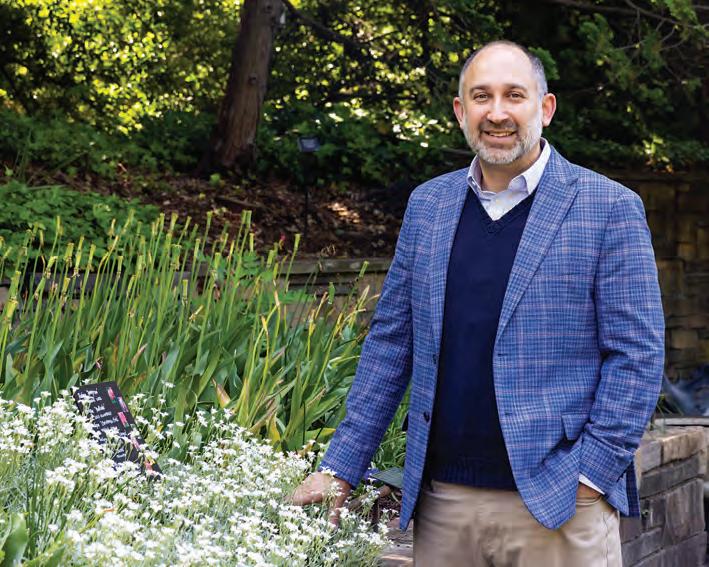
1997 GRADUATE IS STANDING UP FOR NYC GREENSPACES
Nobody lives in a park, so what’s the big deal if a 34-story apartment building goes up nearby?
“Nothing replaces the impact the sun has on plants and trees with its light and heat components,” says Michael Schnall ’97. “Any 8-year-old knows that plants need sun and water to survive!”
In his role with the Brooklyn Botanic Garden (BBG), Schnall’s first day on the job put him deep in the battle to protect sunlight for the garden’s world-class plant collections. He worked with staff, elected officials and neighbors in Crown Heights and beyond to advocate for a revised building plan more respectful of the lush, green collections of BBG.
Schnall joined BBG in 2024 as director of government and community affairs, and is responsible for lobbying the city for funding, building relationships with the community and community boards, and increasing
awareness of the garden. He subsequently became acting chief of staff.
Among other projects, he is advocating for changes to the city’s legislative process so that project planning more routinely considers the impact of sunlight on surrounding properties. In addition, BBG is partnering with the city’s three other botanical gardens to secure funding to make the sites more accessible to visitors. He’s proud to represent what he calls a “regional asset,” citing that BBG was named the second-most beautiful botanical garden in North America and 10th-most beautiful in the world by Titan Travel.
“My classes at Binghamton in public policy helped me understand the impact law and government had on people, and it inspired me to pursue a career where I can have daily impactful conversations and effect positive change in the city.” — STEVE SEEPERSAUD
Cinema grad wins Sports TV Emmys
The 2024 Paris Olympics was a tremendous success for Douglas Weisman ’15. Instead of winning medals, though, he added to his trophy case. Weisman was manager of digital streaming solutions and ingest, working in the Stamford, Conn., headquarters of NBC Sports and earned three Sports TV Emmy awards for the events, giving him a total of six.
“I handle the equipment and processes of receiving video and audio feeds from sporting venues all over the world for distribution to the NBC Sports app, as well as Peacock, for live content,” Weisman says. “My team also helped in recording every competition from start to finish, which our productions used for highlights, live shows and edited pieces.”
As a cinema student, Weisman was hoping to break into the entertainment industry through editing gigs. He struggled to find such work and got his
“in” with NBC Sports through logistics. Weisman assisted with shipping and receiving equipment for the 2016 Rio Olympics and filled in as a media manager, which enabled him to work closely with engineers. Those connections helped him join the transmission engineering department and work multiple Olympics (2016 to present), the 2018 World Cup and Super Bowl LVI.
“[Editing] interested me the most because I enjoyed refining the story and making sure all elements come across as intended in my vision or the client’s vision,” Weisman says. “But, after starting at NBC and seeing the more technical roles in production, I realized that’s what I wanted to be part of.
“I’ve spoken to a few cinema grads about how they can go about breaking into the industry. I tell them it’s not getting the right job the first time, but making the most of it when you get to a company you want to grow in.” — STEVE SEEPERSAUD

1994/ 2003
John Korman ’94 partnered with Michael Lynch ’03 to form Korman Lynch Attorneys at Law. The firm handles serious personal-injury cases, including construction accidents, automobile accidents, wrongful death, general negligence, medical malpractice and the September 11th Victim Compensation Fund.
1995
Cathy Andorfer ’95 wrote The Art of Excellence: Build a Career as a Rockstar Medical Science Liaison and Beyond (Beach House Innovations, 2024), a guide for professionals in the pharmaceutical industry.
1996
Ronald Palmer, PhD ’96, wrote Brother Nervosa (Barrow Street Press, 2024), a poetry collection selected by Kirkus Reviews as a Top 100 Book of 2024.
1997
Seth Marcus ’97 is a senior consultant for health and science at ESRI, the global market leader in geographic information system (GIS) software, location intelligence and mapping.
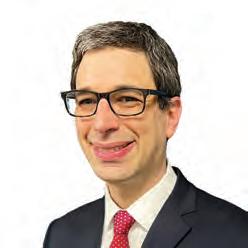
1998
Brent Landau ’98 became executive director of the Public Interest Law Center in 2024. The center uses high-impact legal strategies to advance the civil, social and economic rights of communities in the Philadelphia region facing discrimination, inequality and poverty. Previously, Landau was global managing partner of Hausfeld LLP, where he litigated class actions on behalf of victims of human rights violations, anticompetitive conduct and other wrongs.

2002
Joe A. Katagiri ’02 is deputy commissioner and chief fiscal officer for the New York State Office of Mental Health (OMH). He previously served as OMH’s associate commissioner for managed care, director of the Division of Managed Care, and bureau director of finance and data analytics. Prior to joining OMH, he was associate budget examiner for long-term care and the Affordable Care Act within the state’s budget division.
2006/ 2008
Dara Freeman ’08 married Paul Racioppo ’06 on June 29, 2024, on the coastal cliffs of Cape Neddick, Maine. They welcomed a daughter, Alessandra Evelyn, on April 25, 2025.
2010
Jessica Labella Kitain ’10 was elevated to partner in the family law department at Fox Rothschild. She is based in the firm’s Philadelphia office.
Marcie Katz-Tucker ’10 published a poetry book on the Jewish experience titled You Just Woke the Lions
ALUMNA SUPPORTS REDESIGN OF NYC STREETS
Mona Bruno ’19 is deputy press secretary at the New York City Department of Transportation (NYC DOT). The agency manages a vast network of public infrastructure, including more than 6,000 miles of streets, approximately 800 bridges and the Staten Island Ferry.
“As a member of the press and communications team, I respond to media inquiries as an on-the-record spokesperson,” Bruno says. “I write speeches for the commissioner and other senior agency officials. I also plan proactive announcements to highlight our achievements, like organizing a ribbon cutting for a new protected bike lane.
“Cities across the country are working to reverse the post-pandemic rise in traffic fatalities, and it’s important to redesign our roads to be safer for everyone. I love that my job brings me to all corners of the city where I was born and raised. From exploring car-free streets in Jackson Heights to visiting an art mural at the Shakespeare Steps in the Bronx, no day at NYC DOT is ever the same.
“Binghamton motivated my interest in public service through the philosophy seminars I took as a philosophy, politics and law major. I also worked on a geothermal energy research team which fostered my interest in sustainability.” — STEVE SEEPERSAUD
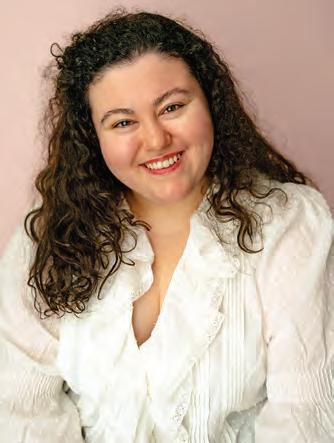

CLOTHING PEEPS AND PUPS IS VITAL TO 2019 GRAD
Gentle, joyful and full of heart:
That’s how Subashkarthick Mohan, MS ’19, describes a venture he started with his wife, Akhila. It’s also how he describes the spirit of their golden retriever, Roony, who was the inspiration for WearPawsitive.
It’s a brand that creates matching apparel for humans and their pups — a variation on Mommy and Me human wear — and every purchase gives back. Mohan donates 15% of profits to animal rescues.
“We’re building a luxury brand with a mission-first heart,” he says. “It’s not just about wearing something cute. It’s about wearing something that matters.”
It’s also about gratitude. When Roony needed unexpected surgery, Mohan realized how fortunate he was to be able to provide care for his canine companion, and that many dogs don’t get a second chance.
Mohan says his engineering background was a strong foundation for launching WearPawsitive; his time at Watson College taught him to approach problems more systematically and lead with logic. As a transformation coach at the University of Maryland Medical System, he helps teams create more efficient, human-centered and sustainable systems. He coaches colleagues on eliminating waste, reducing burnout and improving care.
“This shaped my journey into entrepreneurship,” he says. “In about a year, we’ve shipped across the U.S., and even internationally. We’ve built a loyal community, collaborated with more than 50 influencers and created meaningful awareness for animal rescue.” — STEVE SEEPERSAUD
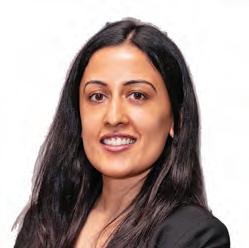
2010
Sana Azadian ’10 was named partner at RAAD, a prominent engineering firm in New York. She has more than 15 years of experience in the real estate and construction industries with deep technical expertise and a comprehensive understanding of the project lifecycle, from design through delivery. As partner, she has broader responsibilities spanning firm operations and business development.
2012
Melissa Cahall ’12 was named School Counselor of the Year for Cabarrus County Schools in North Carolina, selected from more than 100 school counselors in the county.
2014
Ashley Kenny ’14 was named to the Rising Stars in Pennsylvania list for her work in healthcare. She is a senior associate at Pietragallo Gordon Alfano Bosick & Raspanti, LLP.
2020
Noah Cone ’20 joined Whiteman Osterman & Hanna LLP, the (N.Y.) Capital Region’s largest law firm, as an associate in the family and matrimonial law group.
2021
Julianna Mushalla ’21, MS ’22, is a staff accountant in the Schenectady, N.Y., office of Dannible & McKee, LLP, preparing federal and state tax returns for individuals and businesses.
2023
Bernadette Barbarise ’23 is a registered nurse at United Health Services Wilson Medical Center in Johnson City, N.Y.
IN MEMORIAM
Jon Aaronson ’64 died Feb. 6, in Madison, Wis., at the age of 83. He is survived by his wife, Jane; sons David and Joe; daughters Mia and Carmen; and many relatives and friends.
Mark J. Barth ’71 died peacefully at his residence in Yonkers, N.Y., on May 3, 2025. He devoted more than 20 years to improving low-performing schools for the New York State Department of Education.
James Geer ’62 died July 15, 2025, at the age of 84. He was a longtime faculty member in Binghamton University’s Watson College. He was married to his wife, Linda, for 59 years; they had four children and 12 grandchildren.
Christian P. Gruber Jr. ’71 died April 8, 2025. He was the 2009 recipient of the Harpur College Distinguished Alumni Award for the Division of Fine Arts and Humanities. He was the son of Pete and Marilynn Gruber. Pete Gruber was an early member of the Harpur College English Department and was instrumental in the formation of the Theatre Department.
Roslyn (Singerman) Tunis ’72, MA ’79, a pioneering curator and devoted advocate for the arts, died May 7, 2025, in Danville, Calif., at the age of 90.
Robyn L. (Snyder) Gandelman ’89 died in November 2024, at the age of 57, following a battle with multiple sclerosis. She is survived by her husband, Howie; and two adult children, Erynn and Isaac.
Rachel Barag Zagursky ’99 died March 19, 2018, at the age of 40.
George Zebrowski ’95 died Dec. 20, 2024, at the age of 78. He taught the first science-fiction course for credit at Binghamton University in the early 1970s. He is survived by his life partner, Pamela Sargent ’69, MA ’72.
NEW BOOK RELEASES


ARLINGTON
Dennis Vercolen ’74
Austin Macauley Publishers, 2024
Arlington is a love story set against the backdrop of war. It can also be viewed as a timely and cautionary tale about the enduring fight for freedom and justice. The story begins in World War II-era Lisbon, where Manny, an American boy, falls for a captivating French girl, Mari. Their whirlwind romance takes them to France, where they join the resistance against the Nazis. They foil a German plot to loot precious art and treasure, but their fight is far from over.


MICRODOSING FOR HEALTH, HEALING, AND ENHANCED PERFORMANCE
Jordan Gruber ’81, MA ’83 (with James Fadiman)
St. Martin’s Essentials, 2025
According to the authors, microdosing is proving to be a safe, powerful approach to a wide range of health conditions and enhanced performance. For example, people have microdosed to treat depression, ADHD and long COVID, or to achieve enhanced focus and mental acuity. The authors — who recommend that readers consult a physician before embarking on a microdosing program — blend extensive research with personal accounts from contributors around the world.
THIS IS YOUR WORLD TOO
Heather Kahan ’86 and John Kahan ’85 Palmetto Publishing, 2025
This children’s book explores the world through the lens of parents and grandparents whose family lives have been filled with both love and heartache. The Kahans take readers on an expedition across every continent on Earth, showing the beauty of natural wonders and wildlife. The book is also a call to action, as the couple lost their son, Aaron Matthew, to Sudden Infant Death Syndrome (SIDS). The Kahans created a charitable foundation in his name to which all book proceeds will be donated.
WRONGFUL
Lee Upton ’86
Sagging Meniscus Press, 2025
When novelist Mira Wallacz goes missing at a festival celebrating her work, attendees assume the worst — and some hope for it. Ten years later, a reader sets out to discover what happened to Wallacz. Wrongful is a literary mystery dealing with duplicity, envy, betrayal and love between an entertainment agent and a self-deprecating former priest. The book explores how we can be very wrong, time and again, even after we think we’ve discovered the truth. Upton is the emerita Francis A. March Professor of English and writer-in-residence at Lafayette College.
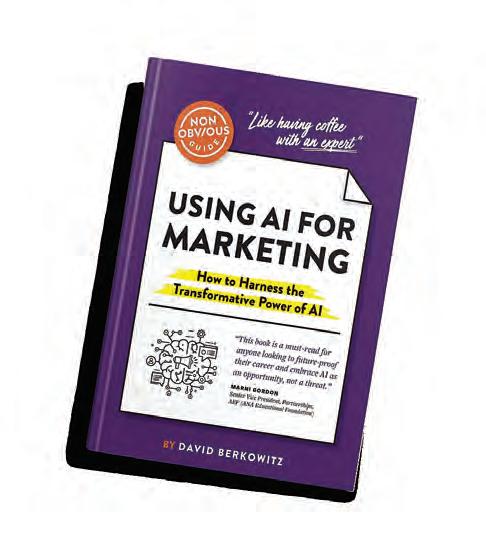

VOICES OF OPERA, 1950S–1970S: INTERVIEWS WITH 22 SINGERS
Tony Villecco ’98
McFarland, 2025
Villecco, a classical tenor soloist based in the Binghamton area, has written the first book of its kind to include interviews with 22 famous opera stars whose careers began in the late 1940s through the 1970s. Opera lovers — and fans of music in general — can peek into the world of opera and examine how the landscape has changed since these pioneers started out. The singers represented in this book recall their memories of having either studied or performed with opera legends.

THE NON-OBVIOUS GUIDE
TO
USING AI FOR MARKETING: HOW TO HARNESS THE TRANSFORMATIVE POWER OF AI
David Berkowitz ’00
Ideapress Publishing, 2025
Artificial intelligence (AI) seems to be everywhere these days — affecting many industries — so it should come as little surprise that the technology is affecting how marketers do their work. Berkowitz, a leader in digital marketing and AI innovation, has produced a book intended to go beyond technical jargon with practical strategies that can enhance anyone’s marketing plans. When leveraged properly, AI can help with improving efficiency, driving sales and gaining a competitive advantage.

TO THOSE WHO HAVE CONFUSED YOU TO BE A PERSON
Alia Dastagir ’05 Crown, 2025
When Dastagir published a story for USA Today as part of a child sexual-abuse investigation, she became the target of a far-right online mob. Although female journalists, politicians, academics and influencers receive an outsized amount of online attacks because of the work they perform, all women online experience hate. Dastagir uses critical analysis from psychologists, sociologists, neuroscientists, technologists and philosophers to offer a deeper look at what women experience during online abuse.
THE WIVES OF HAWTHORNE LANE
Stephanie DeCarolis ’06
Penguin Random House, 2025
With a tree-lined streetscape and impressive homes, Hawthorne Lane looks like the perfect place to live. Of course, looks can be deceiving. Each Halloween, the residents of this envied street come together to host a fall festival. Although it sounds like a fun time, someone won’t survive the night. As the murder investigation plays out, four women find themselves the center of attention, each with secrets worth killing for.
ALUMNA PROFESSOR’S LATEST WORK LOOKS AT THE BEDTIME ADVENTURE OF A ‘GIANT BABY’
Liz Rosenberg, PhD ’97, professor of English, general literature and rhetoric, wrote Giant Baby! (Marble Press, 2025), a children’s book that takes a fun look at where a baby goes at night when his parents think he’s asleep.
Binghamton Magazine: Where did the idea come from?
Liz Rosenberg: From a thought common to all parents of a baby: “What’s happening? It feels like they’re growing five sizes overnight.” The fact that I had a toddler grandson when I wrote the book made that feeling even more clear and poignant. I kept expecting to find his toes had pushed through the onesie pajamas by morning. I also thought it would be a fun story to read and to illustrate — a little like George Shrinks, which moves in the other direction.
My son pointed out, after I’d finished writing it, that I had created a picture-book trilogy: Monster Mama, Tyrannosaurus Dad and Giant Baby! And he’s right. They are all fantastical stories about family.
BM: This seems like a fun story that can be enjoyed by many. Who is the ideal audience for this book?


LR: I think it’s a fun story because of the plot: a giant toddler crashing his way through Manhattan like a human King Kong, and because Eva Byrne’s art is just so brilliant and hilarious. Fairy tales and fantasies touch on something deep inside human consciousness. Toddlers take up an enormous amount of time and space. They destroy things without meaning to. They splash through mud puddles and, if they were big enough, they’d splash through the East River, too.
I write for children, toddlers who can’t read aloud, older kids who can, and the poor parents who often have to read a child’s favorite book 75 billion times.
BM: Your book has some interesting Binghamton connections. Tell us about them.
LR: I’ve been living and teaching in Binghamton for more than 45 years. I earned my doctorate at Binghamton in comparative literature. My roots here are deep. Our wonderful editor is Michael Green, who was a student in my Writing for Children class many years ago. I wrote him a recommendation for an entry-level job at Philomel Books, a branch of Putnam and Viking/ Penguin, and the rest is history. He became president of Philomel and now works for a new, fast-growing publisher called Marble Press. The amazing woman at Marble in charge of publicity for Giant Baby! is Christine Swedowsky, who also has a son at Binghamton! — STEVE SEEPERSAUD
“Coming to Binghamton was one of the best decisions I have ever made.”
— Kristen Eyer ’26

Your Binghamton impact
MOVING STUDENT RESEARCH FORWARD, IMPROVING OUR WORLD
More students than ever are taking their shot at opportunities that define the Binghamton experience. They’re jumping into research, solving real-world problems and launching extraordinary futures.
Kristen Eyer ’26 is one of them.
As an integrative neuroscience major, she’s building on her memory-care work in a nursing home by conducting her own promising Alzheimer’s disease research at Binghamton. Her goal is to become a geriatrician who helps patients maintain their independence and improve their quality of life.
Thanks to Binghamton Fund donors, Kristen received crucial support — an Undergraduate Research Award — to dive deeper into her work and the momentum to pursue her dreams.
Join your fellow alumni in making a difference: binghamton.edu/advancement.
binghamton.edu
SEE THE WORLD IN 2026

Our Alumni Travel Program offers unforgettable sites, well-informed tour leaders and the company of Binghamton alumni.
The Alumni Association and partner travel groups are offering an unprecedented 10 trips next year!
Galapagos Islands (January)
Wonders of Peru (March)
Legends of the Nile (April)
Great European Journey (May)
Greek Island Hopper (June)
Undiscovered Italy (June)
National Parks (July)
Pleasures of Provence (September)
Spectacular Seine River (September)
Iceland Escape (November)
Learn more at bit.ly/BingAlumTravel
